|
The
 News
News
Dedicated to Austrian-Hungarian Burgenland Family History |
THE BURGENLAND BUNCH NEWS - No. 270
October 31, 2016, © 2016 by The Burgenland Bunch
All rights reserved. Permission to copy excerpts granted if credit is provided.
Editor: Thomas Steichen (email:
tj.steichen@comcast.net)
Archives at: BB Newsletter Index
Our 20th Year. The Burgenland Bunch Newsletter is issued monthly online. It was founded by
Gerald Berghold (who retired from the BB in the Summer of 2008 and died in August 2008).
|
Current Status Of The BB:
* Members: 2485 * Surname Entries: 7966 * Query Board Entries: 5576 * Staff Members: 13
|
This newsletter concerns:
1) THE PRESIDENT'S CORNER
2) HER NAME WAS EMILIE (by Patricia Rosa)
3) REMEMBERING THE PAST WHEN WE STILL HAD OUR JEWISH NEIGHBORS (by Meir
Deutsch)
4) SERFDOM: RESTRICTIONS ON TRAVEL, ETC. (Part I)
5) HISTORICAL BB NEWSLETTER ARTICLES:
- BURGENLAND COUNTIES (by Gerald Berghold)
6) ETHNIC EVENTS
7) BURGENLAND EMIGRANT OBITUARIES (courtesy of Bob Strauch)
|
1) THE PRESIDENT'S CORNER (by Tom Steichen)
 After
the bits and pieces here in my "Corner," we continue with Article 2—one
of my favorite types of articles—being a story about personal
discovery by a BB member. Patricia Rosa hadn't known Her Name Was Emilie!
Read the article to find out who Emilie was and how her name was discovered; it
will be worth your time! After
the bits and pieces here in my "Corner," we continue with Article 2—one
of my favorite types of articles—being a story about personal
discovery by a BB member. Patricia Rosa hadn't known Her Name Was Emilie!
Read the article to find out who Emilie was and how her name was discovered; it
will be worth your time!
Article 3 is one by Meir Deutsch, who has written for us previously. His current
article honors the Remembrance Work of people recalling the Past When
Burgenland Still Had Jewish Neighbors. Although I had not planned to publish this
article this month, one of his honorees passed away in September, so I have chosen to move up
its publication.
Article 4, is my effort to shine some light on The Restrictions Placed on Serfs in
Hungary. This is in response to a query from BB member John Rajkovacz about the
Hungarian April Laws of 1848 that included emancipation of serfs as one of the Laws.
The remaining articles are our standard sections: Historical Newsletter
Articles, and the Ethnic Events and Emigrant Obituaries sections.
As a reminder, many, if not most, pictures in the BB Newsletter
have pop-up captions that appear if you hover your mouse cursor over the picture (like my
mugshot picture above). However, images that are self-describing (like the conference banner
below) do not.
I'll also note that our Burgenland Recipes piece almost turned itself into a full-blown
article this month. I think you will enjoy the sociological implications of that simple recipe!

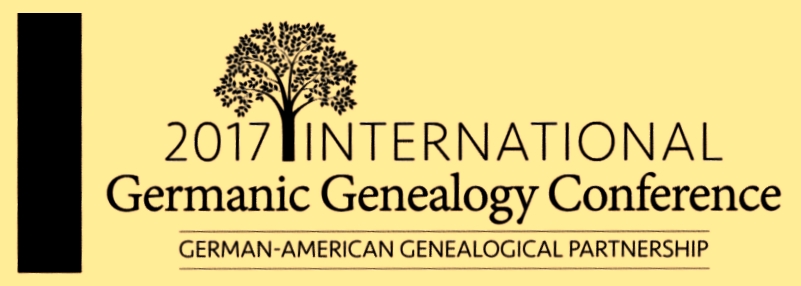 Trans-Atlantic
Germanic Genealogy Conference: John Leier wrote to me to ask that I provide early
notice about a new genealogical conference to be held next summer, July 28-30, at the
Minneapolis Marriott Northwest Hotel in Brooklyn Park, MN. The conference overview can be found
here and the website for the host organization is
http://www.ggsmn.org. Trans-Atlantic
Germanic Genealogy Conference: John Leier wrote to me to ask that I provide early
notice about a new genealogical conference to be held next summer, July 28-30, at the
Minneapolis Marriott Northwest Hotel in Brooklyn Park, MN. The conference overview can be found
here and the website for the host organization is
http://www.ggsmn.org.
As John says, "This is the inaugural meeting of the recently-formed German-American
Genealogical Partnership organization. Many of the attendees and speakers will be from
Germany (and Germanic areas, including Austria) and many Germanic genealogical groups from
around the country and Canada are also going to be well represented. There will be 4-5
presentation slots per day, with a choice of several presentations to attend during each time
slot."
He also notes that there will be time set aside each day for groups to have their own
“special-interest” meetings or get-togethers and that he is interested in coordinating and
hosting one for Burgenland Bunch members and others interested in the Burgenland area.
John also notes that "While it is still 9 months before the conference, we expect the main
hotel to fill before the end of the year, with later registrations going to overflow hotels
located nearby." Thus he advises booking a room early if you wish to be in the main hotel.
To book rooms at the main venue at the conference rate, call (877) 303-1681 and mention
Germanic Genealogy Conference, or reserve online at
http://TinyURL.com/HLUWQQJ. Registration for the conference will open in January 2017.
John has promised to provide more-specific information (how to register, registration fee, etc.)
as it becomes available. In addition, he has set up an email list to allow people to get
directly information as it becomes available. The web page to subscribe to the list is here:
listinfo/intl-germanic-genealogy-conference.

 Burgenland/July
2016: Heimatabend in Stegersbach: Burgenland/July
2016: Heimatabend in Stegersbach:
Bob Strauch writes: "On the Facebook page of the First Burgenländer Society of New York
there are videos that were recorded on July 8, 2016 at the Heimatabend in Stegersbach
with Rudi Pietsch and his Tanzgeiger:
Facebook/First-Burgenlander-of-New-York."
Editor: These videos are relatively low resolution but are accessible even if you
do not have a Facebook account. Also, Bob does not mention that he is also playing with the
group on many of the videos... but he is!

 Roswitha
Marton wrote to Members Editor Johnny Santana: Roswitha
Marton wrote to Members Editor Johnny Santana:
Hello Johnny, I have tremendous news regarding my family search. When I was in Pinkafeld
and visited my grandparents grave, I left a message in a bottle with a label for anyone caring
for the grave to read. I have now found my father's sister and cousins. I am so excited and
wanted to share this with you. I thought it was worth trying and it worked.
Johnny passed the message along to me, saying he "thought that it was a very
clever and imaginative approach in seeking possible relatives in the Heimat. I'd never even
thought of it! I was wondering if you might like to include it in the upcoming newsletter. Our
members never cease to amaze me with their creativity." Of course, I agreed, so here it is!

 Burgenland-Related
Research Survey: Although I sent a separate note concerning this, I wish to remind you
about the Online Research Survey being undertaken as part of his Master’s thesis by Martin
Schmall, a graduate student in Agriculture and Food Industry at the University of Natural
Resources and Life Sciences in Vienna, Austria. As I said in that note: Burgenland-Related
Research Survey: Although I sent a separate note concerning this, I wish to remind you
about the Online Research Survey being undertaken as part of his Master’s thesis by Martin
Schmall, a graduate student in Agriculture and Food Industry at the University of Natural
Resources and Life Sciences in Vienna, Austria. As I said in that note:
His survey concerns the impact of the TTIP (Transatlantic Trade and Investment Partnership, also
designated T-TIP) on the food retail sector of the economy. His survey is being conducted
simultaneously in Austria and the United States. He asks that we please take time to fill out
the survey (it takes at most 5 minutes).
If you are like me, you have not heard of the TTIP, but the survey also includes interesting
questions about your preferences concerning foods, be they organic, genetically modified or
pesticide free; the type of food stores you prefer; and the cost-versus-quality assessment you
employ.
Here is the link to the survey:
https://www.umfrageonline.com/s/TTIP-EN (“umfrage” is German for “survey”).
In trade, I have asked Martin to share a summary of his findings with the BB (when the survey is
complete), as I’m sure any differences between Austrian and US views on these subjects will be
interesting. Please consider supporting his research efforts by filling out the survey.
Although I ask you to fill out the survey based on your current knowledge, after you are done
you can look up information about TTIP on the US Trade Representative government website
https://ustr.gov/ttip. I'll also mention that TTIP is
similar in nature to previous trade agreements NAFTA (North American Free Trade Agreement) and
TPP (Trans-Pacific Partnership)... both of which are also mentioned on that government site.

 St.
Louis Online Genealogical Resources: Margaret Kaiser passed along information about
genealogical resources (newspaper databases) relating to the St. Louis area: St.
Louis Online Genealogical Resources: Margaret Kaiser passed along information about
genealogical resources (newspaper databases) relating to the St. Louis area:
Obituary Index - The St. Louis Public Library has made available an obituary index
(http://www.slpl.org/slpl/gateways/article240117800.asp
). The records in the database are drawn from death notices, burial permits, and obituaries
published in the St. Louis Post-Dispatch from 1880 to 1930, 1942 to 1945, 1960 to 1970, and 1992
to 2014. Search by last name, first name, and year of birth or death.
An addendum (http://www.rollanet.org/%7Ebdoerr/P-D/PD75-77.htm)
to the St. Louis Post-Dispatch obituary index covers January 1975 to June 1977.
Death Index - The St. Louis County Library's web site also provides a database of
deaths (http://www.slcl.org/content/index-deaths-saint-louis-globe-democrat)
in Missouri and Illinois. Drawn from the St. Louis Globe-Democrat and its predecessors, this
index currently covers 1860 to 1861, 1880, 1881, and 1883. More years are being added as
indexing is completed.
Email the History & Genealogy librarian (genealogy@slcl.org)
with subject "Index to deaths in the Saint Louis Globe-Democrat" to request a copy of an
article.
These links will be added to the BB Links page.

Mural at Coplay Sängerbund: In the previous newsletter, I included a few words
from BB member Bob Schatz commenting on the mural found in the entrance to the Coplay Sängerbund
in Coplay, PA. I also asked if any of you are aware of any similar work found in a US (or other)
emigrant Burgenländer destination and, if so, to share an image and possibly some background
information about it. To date, I have not heard from anyone concerning a similar
Burgenland-related work... but my request remains open!

Beyond that, I asked for information about the origins and artist(s) behind the Sängerbund mural
(shown above) and the meaning of the dates on the inscription.
Bob Strauch quickly replied, saying:
The mural of the Güssinger Schlossberg at the Coplay Sängerbund was painted by Sally
Simitz of Coplay, wife of local musician Emil Simitz. It was done on the occasion of the
club's 75th Anniversary in 1992 (hence the dates 1917 & 1992).
So now we know. Thanks, Bob!

 Brothers
Grimm Fairy Tales in the Hianzisch Dialect: Karin Ritter, of the Burgenländisches
Volksliedwerk (Burgenland Folk Song), asked that I publish information about a new double-CD
set containing 13 Brothers Grim fairy tales presented in the Hianzisch dialect. The double-CD
was produced in cooperation with the Burgenländisch Hianzischen Gesellschaft in
Oberschützen and is based on text from their 2015 book, "Dou woar amul...", which
contains 27 of the best-known Brothers Grimm fairy tales, also presented in the Hianzisch
dialect. The double-CD was motivated because many readers of the book reported that they had
great problems reading the dialect, as Hianzisch is mostly a spoken, not written, dialect. Brothers
Grimm Fairy Tales in the Hianzisch Dialect: Karin Ritter, of the Burgenländisches
Volksliedwerk (Burgenland Folk Song), asked that I publish information about a new double-CD
set containing 13 Brothers Grim fairy tales presented in the Hianzisch dialect. The double-CD
was produced in cooperation with the Burgenländisch Hianzischen Gesellschaft in
Oberschützen and is based on text from their 2015 book, "Dou woar amul...", which
contains 27 of the best-known Brothers Grimm fairy tales, also presented in the Hianzisch
dialect. The double-CD was motivated because many readers of the book reported that they had
great problems reading the dialect, as Hianzisch is mostly a spoken, not written, dialect.
A link to information about the CD set on the Burgenländisches Volksliedwerk site is:
http://burgenland.volksliedwerk.at/pages/bakery/dou-woar-amul-250.php
[As always, the BB offers information about commercial endeavors for information only. We do
not endorse any products and have not reviewed this offering (except to say that the link given
is both correct and safe).]

War Memorials and Graves Resources: BB member Andreas Schoredits recently wrote to
share information on two online resources related to War Memorials and War Graves.
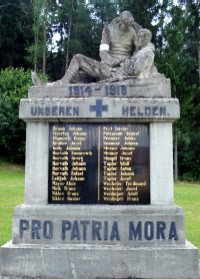 The
first site helps find the gravesites of fallen WW-II German and Austrian soldiers:
http://www.volksbund.de/en/graebersuche.html. The
first site helps find the gravesites of fallen WW-II German and Austrian soldiers:
http://www.volksbund.de/en/graebersuche.html.
The other website lists the fallen of both world wars, as compiled from monuments erected in
graveyards:
http://www.denkmalprojekt.org/en_search.htm. Andreas says "There is a lot of
information... and includes all the villages in Burgenland."
I spent a few minutes on each site and will note that the first site requires that you fill out
a registration form before it provides search results. This only needs be done once.
The second site provides two search engines, the Fluid Dynamics search engine and the
Google search engine. However, the Fluid Dynamics engine does not appear to be
functional... but Google's works fine. In addition, there is a direct link to
Burgenland's war memorials:
http://www.denkmalprojekt.org/covers_oe/burgenland.htm.

Julius Streicher Collection—Research Help Requested: Felix
Gundacker, of www.GenTeam.eu, recently sent a note
concerning WW-II looted books located in Nuremberg, specifically the Julius Streicher
Collection, and requesting assistance in restoring the books in the library to their
rightful owners or their descendants.
This is a collection of approximately 10,000 valuable books—the so-called “Stürmer or
Streicher Library"—stolen during the war by the Nazis and now custodially administered by
the Jewish Community (Israelitische Kultusgemeinde, IKG) Nuremberg. A goal of the
IKG is to restore the books to their legitimate former owners or their rightful heirs.
Such restitution is completely free of charge, even to the mailing of the books back to their
rightful owners. Although many of the probable owners of the books have been identified, it has
proven quite difficult to determine where they or their legitimate successors live now. Thus
this request for help.
The current list of probable owners (i.e., robbery victims) or known successors (the list is not
clear) can be found on the GenTeam site (no registration needed) here:
Streicher Collection Owners. Other books still require initial provenance research and all
books require reasonable documentation to ensure rightful ownership. Please look at the list and
consider whether your family or acquaintances might be an owner. In addition, if family lore
suggests your family might have been so victimized, please consider making contact (as described
below).
Below is a letter from Magister Leibl Rosenberg, the representative of the city of
Nuremberg for the collection of the IKG that explains more and asks that you contact him
with any and all research findings and questions (at
Leibl.rosenberg@stadtnuernberg.de).

Looted books Not Only from Austria in the Collection of the Jewish Community
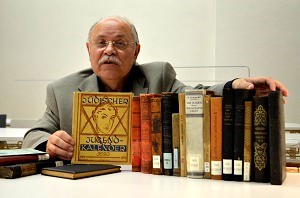 On
March 12, 1938, Nazi Germany brought Austria home into the Reich (realm) by annexing the
country. With it began a terrible history of suffering for the victims of the Nazis: Jewish
people, free masons, Sinti and Roma, priests and believers of diverse Christian
denominations, representatives and exponents of the labor movement. They were disenfranchised,
humiliated, persecuted, arrested, robbed, expelled, and assassinated. Favored objects of the new
masters’ desires were the properties and cultural commodities of any kind: paintings,
sculptures, images, manuscripts, writings, archival materials, art wares, tools and instruments,
stocks, motor vehicles, furniture and usable items of any kind. One does not go wrong in the
assumption that there had to have been about 600,000 art works and millions of publications
confiscated from all over Europe. On
March 12, 1938, Nazi Germany brought Austria home into the Reich (realm) by annexing the
country. With it began a terrible history of suffering for the victims of the Nazis: Jewish
people, free masons, Sinti and Roma, priests and believers of diverse Christian
denominations, representatives and exponents of the labor movement. They were disenfranchised,
humiliated, persecuted, arrested, robbed, expelled, and assassinated. Favored objects of the new
masters’ desires were the properties and cultural commodities of any kind: paintings,
sculptures, images, manuscripts, writings, archival materials, art wares, tools and instruments,
stocks, motor vehicles, furniture and usable items of any kind. One does not go wrong in the
assumption that there had to have been about 600,000 art works and millions of publications
confiscated from all over Europe.
A portion of the stolen books from 514 Austrian towns and other localities in Europe reached by
still obscure ways into the ownership of the infamous Gauleiter (head of a Nazi
administrative district) and so-called Frankenführer (Franconian leader) Julius Streicher
in Nuremberg. Remnants of the books remain to this day in the collection of the Jewish
Community-IKG (previously the collection was also known as the Stürmer or Streicher
Library) in the Nuremberg city library at the Educational Campus. This collection of nearly
10,000 books is the property of the Jewish Community in Nuremberg and was given, years
ago, on permanent loan to the city library. The IKG, owners and proprietors of the
collection, saw and see themselves as custodians, and they have begun, with great effort, the
tedious task of finding the former owners and the restitution of the writings to their legal
successors. So far, more than 700 writings were returned to approximately 170 persons or
entities in ten different countries. This work is done pro bono; therefore, it is done
free of charge for the previous owners, their families and rightful owners, and the city of
Nuremberg will pay the postage to forward restored works.
The research of the provenance references in the writings in 25 languages has resulted in over
2,200 former owners from localities in Europe and overseas. Three geographical focal areas have
been crystallized: Nuremberg, Franconia; Strasbourg, Alsace-Lorraine; and Vienna, Austria.
The restitution of robbed cultural goods requires provenance research; in turn, it cannot be
successfully made without family research. The acting representative of the city of Nuremberg
for the Collection IKG therefore turns today, a good year after sending out the first
search list, once more to the genealogists and historians from the staff and user circle at www.GenTeam.eu
to request instructions, reference information, and research result for locating former owners
and their heirs or legal successors. The list published here still contains some inaccuracies
and misattributions, traces and fragments despite many of years of careful efforts to avoid
errors. It is a matter of 879 former owners of 238 known cities throughout Europe. A list as
this one, how could it be any different--a document of mass lootings that often lead to mass
murders!
Many years, actually decades, have passed since this terrific raid; but it does not alter the
iniquity and the suffering of the affected. Please examine whether you can shed some light in
the dark, so that in this way the victims will befall just a little justice. The first Search
List with Austrian victims of these robberies at GenTeam lead to the restitution of
written works and to the clarification of dozens of former owners. For this and for the great
and selfless helpfulness of our GenTeam friends is expressly and warmly thanked!
Leibl Rosenberg, M.A.
Representative of the City of Nuremberg for the Collection IKG
In der Stadtbibliothek im Bildungscampus Nürnberg
Egidienplatz 23, Zimmer 207
90403 Nürnberg
(0049)-(0)911-231-22588
Leibl.rosenberg@stadtnuernberg.de

 Update
for book "The Burgenländer Emigration to America": Here is this month's update on
purchases of the English issue of the 3rd edition of Dr. Walter Dujmovits' book "Die
Amerika-Wanderung Der Burgenländer." Update
for book "The Burgenländer Emigration to America": Here is this month's update on
purchases of the English issue of the 3rd edition of Dr. Walter Dujmovits' book "Die
Amerika-Wanderung Der Burgenländer."
Current total sales are 1095 copies, as interested people purchased 15 more books during these
past two months.
As always, the book remains available for online purchase at a list
price of $7.41 (which is the production charge for the book, as we purposely
choose not to make a profit so we can avoid dealing with the income tax consequences and
so you can obtain the book at as low a cost as possible!), plus tax & shipping. See the
BB homepage for a link to the information / ordering page and for
any current discounts (and there is at least one discount on price or shipping available most of
the time... if not, wait a few days and there will be one!).

 Burgenland
Recipes: Eszter Tóth, of Vác, Hungary (who shared a Burgenland trip report
with us in Newsletter #268), tells me that her grandfather wrote up the old recipes of his wife
(her grandmother) in about 1917. Eszter shares one for "Dara Puding," saying "It
was family legend that this recipe was coming with my great-grandmother, so maybe has Burgenland
roots. Anyway I love it." Burgenland
Recipes: Eszter Tóth, of Vác, Hungary (who shared a Burgenland trip report
with us in Newsletter #268), tells me that her grandfather wrote up the old recipes of his wife
(her grandmother) in about 1917. Eszter shares one for "Dara Puding," saying "It
was family legend that this recipe was coming with my great-grandmother, so maybe has Burgenland
roots. Anyway I love it."
Dara is a Hungarian word for semolina = farina = Cream of Wheat, and
the pudding is so named because Dara is the base ingredient for the pudding. As prepared
in the recipe below, it is topped with a custard/milk sauce. On the web, you can find many
variations on Dara Puding ...some recipes blend fruit into the pudding or top it with a
fruit-based sauce. There are also fancy versions with a chocolate or caramel topping and simple
versions with just a cinnamon or powdered sugar or cocoa dusting.
Although I looked, I could not find a Dara Puding pictured with the custard-sauce
topping, so I was planning to show just the recipe itself... but when I mentioned this to
Eszter, she decided to treat herself to the pudding and provided a series of photos of the
preparation steps... I'll share them after the recipe, along with the comments she sent with the
pictures.
But first, here is Eszter's custard-topped Dara Puding recipe, complete with
grandfather's original hand-written instructions:
DARA PUDDING (from Eszter Tóth)
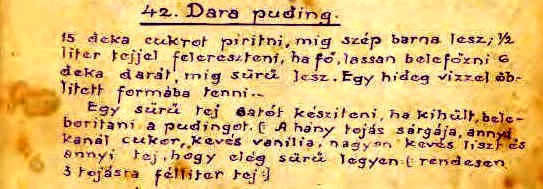
3/4 c. sugar 2 cups + 2 tablespoons milk
1/3 c. semolina
Caramelize 15 dekagrams [3/4 cup] of sugar until nicely brown. Blend in 1/2 liter [2 cups plus 2
tablespoons] milk and heat to a slow boil. Stir in 6 dekagrams [1/3 cup] semolina and cook until
thickened. Rinse a mold [cake or pudding form] with cold water, pour in the pudding, and chill.
Now prepare a thick custard. Then, when the pudding has cooled, unmold it onto a deep platter
and pour the custard on top.
Custard (Milk Sauce) topping:
3 egg yolks 3 Tbsp. sugar
dash of vanilla a bit of flour
2 c. milk
Blend all ingredients together then stir over low heat until thickened to a smooth, dense liquid
(1 minute of boil). In general, use as many egg yolks as tablespoons of sugar, a little vanilla,
a little flour to thicken it, and just enough milk to make it a smooth, dense liquid (usually
1/2 liter of milk [about 2 cups] to 3 egg yolks).

Eszter's Pictures and Comments
Ingredients of the first step: milk, sugar and semolina

Use a deep pot for caramelization, because when you pour the milk—very, very slowly—it is
similar to a volcano.
Don’t forget to make the form wet, just before you pour the pudding into it.
The result of the first step. It is just cooling now:

The ingredients of the second step: milk, egg yolks, sugar, vanilla, and flour

First, thoroughly mix the sugar, egg yolks and a little flour in the pot. Then add the milk and
vanilla. Cook it until it boils for a minute. Stir it continuously!!!!
The results of the first two steps:

I tasted them, as you can see!
Enjoy your meal! (Jó étvágyat!)
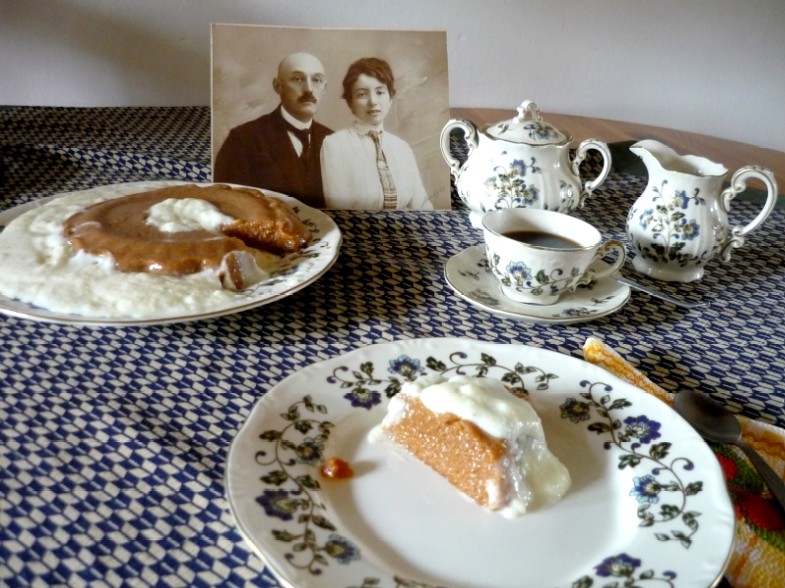
Dara Puding; grandfather, who put down the recipe; grandmother, who made the original
version; my afternoon coffee; AND my first taste of the Dara Puding!
Thank you, Tom, for this nice and sentimental afternoon!
[Ed note: That looks awfully good! ...but Eszter did not send me a slice like I
asked! lol]

Given that the original recipe was not completely clear about all the steps in
preparing this dish, I also consulted with my BB Hungarian translators, Julia
Szent-Gyorgyi and Réka Kieß, who both assisted in completing the write-up.
My thanks to them!
Réka tells me that this is "...an age-old recipe, one of the earliest and cheapest
dessert recipes known in Hungary." She also says that "...this is only a variant
of "Tejbegríz" (semolina in milk), which is prepared in a saucepan and eaten hot and
creamy with cocoa or cinnamon topping on it. It is still a typical dish of nursery schools and
people with problems of the digestive system."
She goes on to say that "...custard topping was mainly used by middle-class
families, since vanilla was not an option for the poor. Tejbegríz was only made into a
semolina pudding when there was a topping to go with it. Jam, marmalade, custard of any type,
was something that only the higher classes could afford. Therefore, semolina pudding is not
something that you would usually eat on a Sunday afternoon if you were from the lower-middle
classes or even less fortunate. Dessert would rather be Tejbegríz or Rizskoch
(Note: Hungarian word for rice is "rizs." This is then compounded with a German verb: "koch"
[to cook]. This is how using etymology you can depict the original birth time of a recipe,
especially around special cases like Burgenland.)"
I'll remind you readers that Réka has expertise in paleography, which is
the study of ancient and historical handwriting.... Included in the discipline is the practice
of deciphering, reading, and dating historical manuscripts, and the cultural context of writing.
Thus it is not surprising that Réka considers and interprets the etymological background of
words. In fact, she also speculates about the background of the writer of the recipe, saying:
"The writing and language of the recipe shows that the person putting it down was a
literate, well-educated person. I have seen many types of writing and language use from this
era and I can say that this person seems like a clerk or someone doing an office-based job."
This prompted me to ask Eszter Tóth if this was an accurate assessment of her
grandfather and his occupation. In addition, I asked her about the "class" background of her
great-grandparents and grandparents... that is, was their class background consistent with
having a custard-topped semolina pudding (middle class or higher)? Here is what she says:
"My grandfather was an engineer, who worked with rivers, lakes and roads. He finished
[his] University studies in Budapest in 1899, but he worked (when he put down the recipes) in
Nagyszalonta [now Salonta, Romania], a small town near Nagyvárad / Oradea [, Romania]. In the
family tree of my grandma, at least 6 generations were Bürgers [citizens], Lederers
[leather workers], Fleischackers [butchers], Tuchmachers [cloth makers],
Webers [weavers] and evangelical Teachers, Pastors and Superintendents (Bishops).
"So, ...they were middle class people. The engineer (my grandpa), the priest, the teacher and
the rabbi played tarokk (a game with cards) on Sunday afternoons. They were the
literate, well-educated persons in the small town.
"When I was a small child (in the 1950s), my family was very poor (in Budapest with my
parents). But once a week we (the children) got Tejbegríz, with a small [bit of] sugar
on top of it. After 1956 the situation was better. Then my mother made Dara Puding for
us. And we thought, at that time, we were very rich and [that] Dara Puding was
completely different from Tejbegríz. (Even in those days, the vanilla was sent by my
grandma from Oradea, Romania.)"
Thus it should be quite apparent that Réka's assessment of the writing was
spot-on accurate, as was her interpretation of the class distinctions between Dara Puding
and Tejbegríz!
I hope you readers enjoyed the history/sociology lesson and will enjoy making Dara Puding
for yourself!

 Reminder:
As mentioned a few newsletters ago, I no longer have a "regular" source for Burgenland recipes.
As above, a few readers have shared favorite family recipes so I'm good for a few months, but
then I'll be begging again! So, please consider sharing your favorite Burgenland recipes
or recipe books with me so I can share them with the readership... and so our ethnic dishes do
not get washed away by the ever flowing river of time and become lost to our future generations.
Thanks! Reminder:
As mentioned a few newsletters ago, I no longer have a "regular" source for Burgenland recipes.
As above, a few readers have shared favorite family recipes so I'm good for a few months, but
then I'll be begging again! So, please consider sharing your favorite Burgenland recipes
or recipe books with me so I can share them with the readership... and so our ethnic dishes do
not get washed away by the ever flowing river of time and become lost to our future generations.
Thanks!

Cartoon of the Month: This newsletter is dated Oct. 31, after all!

|
2) HER NAME WAS EMILIE (by Patricia Rosa)
 Holling
destroyed its church records in 1946, taking my family history and leaving more questions than
answers. I knew my great-grandparents' names, but not their birth or death dates. My mother
always spoke about her step-grandmother and how much she loved her, and vice-versa,
but I didn’t know even her name. Holling
destroyed its church records in 1946, taking my family history and leaving more questions than
answers. I knew my great-grandparents' names, but not their birth or death dates. My mother
always spoke about her step-grandmother and how much she loved her, and vice-versa,
but I didn’t know even her name.
My mother passed away in 2008 so my husband never got to meet her. When I told him that her
family left Hungary in 1946 after the war, he said, “the war was over in 1945.” Thus I
questioned for the first time what happened during the time in between, as all my understanding
of my family history was now challenged.
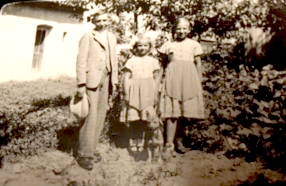 I
searched online unsuccessfully for Holling, Hungary. My next step was to scour the boxes
that my brother Larry stored for me—all the things I wanted to keep
from my parents’ home but didn’t have space for myself. One after another, we looked through a
box and then replaced it and started another. I
searched online unsuccessfully for Holling, Hungary. My next step was to scour the boxes
that my brother Larry stored for me—all the things I wanted to keep
from my parents’ home but didn’t have space for myself. One after another, we looked through a
box and then replaced it and started another.
I opened a box and found a copy of mother's Hungarian birth certificate: Janka Kölly; her
father Lorinc; mother Ilona. Holling was German-speaking so it was strange to
learn their Hungarian names. Halfway through the box, I pulled out a curious document with
discolored pages but in good shape (pdf copy here:
VertreibungHolling). With my elementary German proficiency, I could read some of it. Our
family’s names jumped off the page, and Larry and I thought this was a family document of some
kind. He scanned a copy and I took the original, along with many pictures, back home with me.
The next morning, I opened my online translator and began my research with “Bei der
Vertreibung im Jahre 1946.” I knew my family left Holling in June of 1946 and I recalled my
husband's “why in 1946?" question. I had never questioned why before, I just
accepted it as fact. I hit “translate” and EXPULSION flew off the page.
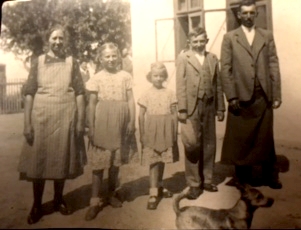 Expulsion?
Wait, what? I Googled expulsion and read everything I could. I cried for the 13-year-old
girl, forced to leave everything behind. My siblings and I didn’t know half of the story, not
even close. I was confused, and I didn’t understand why I didn’t learn this from my mother? Why
weren’t they bitter? I don’t understand. Expulsion?
Wait, what? I Googled expulsion and read everything I could. I cried for the 13-year-old
girl, forced to leave everything behind. My siblings and I didn’t know half of the story, not
even close. I was confused, and I didn’t understand why I didn’t learn this from my mother? Why
weren’t they bitter? I don’t understand.
I read somewhere that “Germans were wonderful list makers.” This Vertreibung list
documents 127 total households, with father, mother, grandparents, and even all the children.
Occupations too. 717 people in total for the village... 159 who remained in Hungary. Also noted
are some who died in the war and some that never returned. The village had two schools, a
stable, and 697 animals, mostly oxen and cows. 15 people left prior to the expulsion; my
great-grandparents probably were part of this group (I learned later that my great-grandfather
"knew enough" of the Russians).
I began an amazing journey. I found my grandfather’s obituary among the pictures I had taken and
I began to translate it. I knew his mother died when he was six, but I had no idea about his
father—my great-grandfather had been a Russian P.O.W. for seven years
in WW-I! My great-great-grandparents raised my grandfather and his sister, Luise, during this
time.
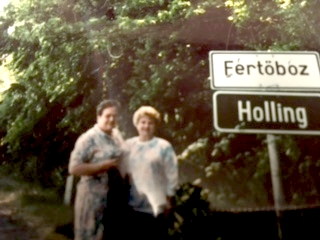 I
located a picture of my mother standing in front of the Holling/Fertöboz sign on
her first return trip to Holling in 46 years. Now it made sense, and I began searching
Fertöboz... our village came to life for me! Fertöboz was mentioned in a
Burgenland Bunch newsletter, so I became a member. Through this group, I connected with my
distant cousin in Germany! Her grandfather and my grandfather were cousins. I remembered meeting
her grandfather several times when I was with my Opa. We exchanged emails and pictures.
She shared with me some family history out of a book about Holling. I now have so much more
information, dates, and the names of my great-great-grandparents. One name that still eluded me
was the name of my step-great-grandmother. I returned to my document—and
there it was! Emilie, her name was Emilie. I
located a picture of my mother standing in front of the Holling/Fertöboz sign on
her first return trip to Holling in 46 years. Now it made sense, and I began searching
Fertöboz... our village came to life for me! Fertöboz was mentioned in a
Burgenland Bunch newsletter, so I became a member. Through this group, I connected with my
distant cousin in Germany! Her grandfather and my grandfather were cousins. I remembered meeting
her grandfather several times when I was with my Opa. We exchanged emails and pictures.
She shared with me some family history out of a book about Holling. I now have so much more
information, dates, and the names of my great-great-grandparents. One name that still eluded me
was the name of my step-great-grandmother. I returned to my document—and
there it was! Emilie, her name was Emilie.

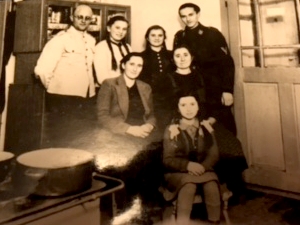 Ed.
Note: The Holling/Fertöboz deportation-related document has been added to the BB's
Emigration & Deportation
page. Readers are invited to share any lists of deportations or emigrations they have for
inclusion in this page. My thanks to Patricia for sharing hers (and her story). Ed.
Note: The Holling/Fertöboz deportation-related document has been added to the BB's
Emigration & Deportation
page. Readers are invited to share any lists of deportations or emigrations they have for
inclusion in this page. My thanks to Patricia for sharing hers (and her story).
In addition, Patricia is wondering if anyone can identify the military uniforms of
the men standing in the picture to the right (a bonus would be if you also know the mens'
names). My guess is that the uniform on the left is a German Wehrmacht summer tunic and
the right is for a German infantry acting corporal (Gefreiter), but I am not very
knowledgeable about military uniforms (and the picture is not real detailed!).
|
3) REMEMBERING THE PAST WHEN WE STILL HAD OUR JEWISH NEIGHBORS (by Meir
Deutsch)
Editor: Meir Deutsch wrote the first draft of the following article back in July...
and I have been holding it with intent to publish it when it seemed appropriate. The article
honors Gentiles who have found it important to remember Burgenland's Jewish past, a past largely
wiped out by the Nazi's during WW-II.
Unfortunately, one of his honorees, Gertraud Tometich, died September 13th, so I have chosen to
publish Meir's article now as a partial eulogy about her. The organization she founded as part
of her remembrance work, "wir erinnern - Begegnung mit dem Jüdischen Mattersburg" (We Remember -
Encounter with Jewish Mattersburg), published the following "Remembrance" notice:
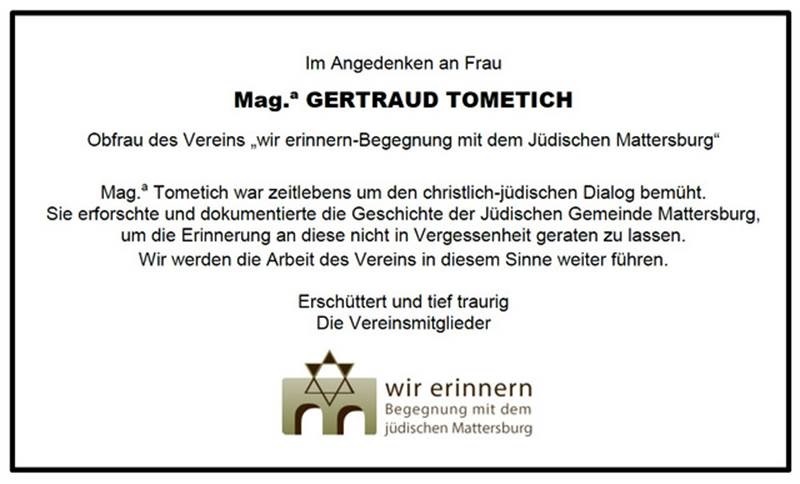
I translate this as:
In Remembrance of Woman
Mag. Gertraud Tometich
Chairwoman of the Association "We Remember - Encounter with Jewish Mattersburg"
Mag. Tometich was concerned about the Christian-Jewish dialogue.
She researched and documented the history of the Jewish Community of Mattersburg
in order not to let the memory of it fall into oblivion.
We will continue to lead the work of the Association in this sense.
Shaken and deeply sad
The Association Members
Thus, it appears that she will not be forgotten nor that her work will be lost. In a world
where organizations (like ISIS) still strive to erase history and destroy people whose ways
differ from their own, it is good that others wish to remember... largely in the hope, I
suspect, that such remembrance will, even if just a little, keep good people from doing such
terrible things again.

REMEMBERING THE PAST WHEN WE STILL HAD OUR JEWISH NEIGHBORS
Meir writes: The first thing done in Mattersburg was restoration of the former
Jewish cemetery. As we know, the Jewish cemetery was the only one in Burgenland that was
destroyed in WW-II; most of the tombstones were broken up. Some of the tombstones were used to
cover part of the Wulka River, which runs in the town. The old cemetery was now a flat piece of
land in the center of the town. A concerned gentile inhabitant, Walter Pagler, did not like the
playing of football in the summer and ice skating in the winter on that plot. He established the
"Verein Shalom" (it doesn't exist anymore), which placed identical stones, which resemble
tombstones and were marked with the Shield of David (no names), all over the cemetery.
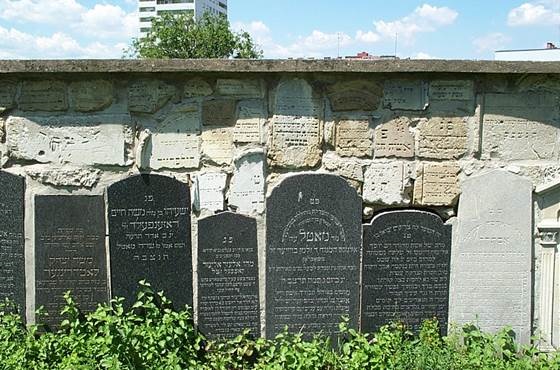
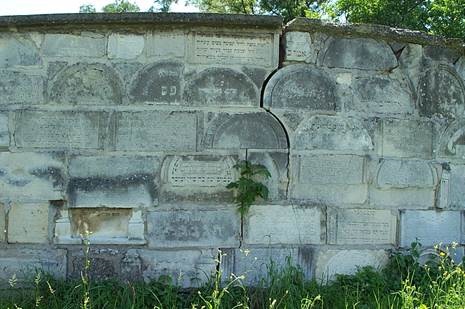
Broken up tombstones plastered on a wall without any order
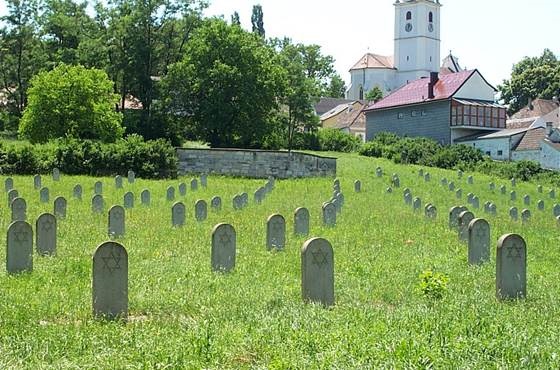
The new, identical stones in the cemetery
Mag. Gertraud Tometich wrote a book, "Als im Burgenland noch das Schofarhorn ertönte"
(When in Burgenland the Shofar Horn still Sounded), about her town's Jewish past. She has no
command of Hebrew or the Hebrew Alphabet, but came to Jerusalem to visit Rabbi Akiva Ehrenfeld,
the son of the last Rabbi of Mattersburg. Being a local, she had access to the many documents
and pictures, some of which we can find in her book. The pictures in her book are of the best
quality that I have seen.
After writing her book, she established the "Wir-Erinnern – Begegnung mit dem jüdischen
Mattersburg” (We Remember – Encounter with Jewish Mattersburg), whose work is the
remembrance of the time when there were still Jews in Mattersburg. Here is their webpage:
http://www.wir-erinnern.at. I will
not elaborate on the Verein's work; one can find such information on their web pages.
There is a street named after Dr. Richard Bertzeller, who was the Jewish medical doctor and also
author of a few books on Mattersburg. Lately there was a decision made by the municipality,
initiated by Wir-Erinnen, to name a lane after Rabbi Samuel Ehrenfeld, the last Rabbi of
the town. The lane is along the Wulka River.
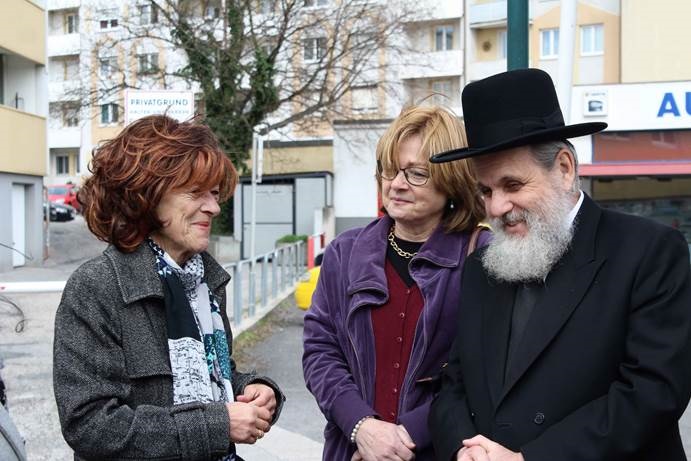
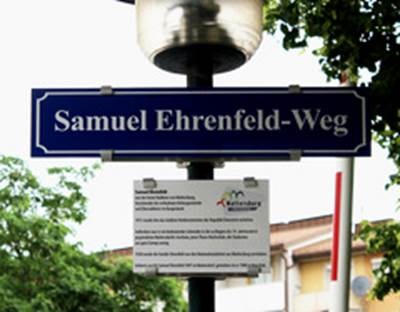
Left: Ms. Gertraud Tometich with Dvora and Rabbi Yitzhak Ehrenfeld, grandson
of the last Rabbi, on his visit to Mattersburg; Right: The lane named after the last Rabbi of
Mattersburg
As Ms. Tometich is also lecturing to the school children in the town and to visitors who are
interested in the Jewish life that was there, she asked me to build a slide show about Jewish
life in their town that can be shown to pupils. I composed a slide show and sent a draft of it
to her quite some time ago. She needs approval; therefore she contacted the Managing Director of
the Literaturhaus in Mattersburg and asked him to contact the department to get the approval.
She tells me that she approached him a few times, but up to now she did not get the approval.
The slide show is a factual History, well documented; therefore I cannot guess why permission
was not given up to now. Can someone explain to me what the reason can be? I asked Ms. Tometich
if the school children are familiar with one of the most read of their (Austrian) writers –
Stefan Zweig? She said that she remembers one of his books: The Chess Players. I
recommended that she, and the schoolchildren, should read his last novel: "Die Welt von
Gestern" (The World of Yesterday). It would give them a wider view of Austria.
Recently, there was another project concerning Mattersburg. This was done by a German student,
Veronika Schmid, studying architecture in the Technical University in Vienna. Her Diploma work
was on the Jewish Synagogue in Mattersburg. The synagogue's interior was looted and destroyed,
and finally blown up in 1940. There is no architect's or floor plan and not many photos of the
synagogue. There are no photos of the interior except the one toward east. There is none of the
entrance hall or the women's gallery. Even knowing of these obstacles she took on the project
and finished it. Besides others, she also approached me. I tried to assist her as much as I
could.
You can see her project here:
http://publik.tuwien.ac.at/files/PubDat_245009.pdf. Here are some pictures of her work:

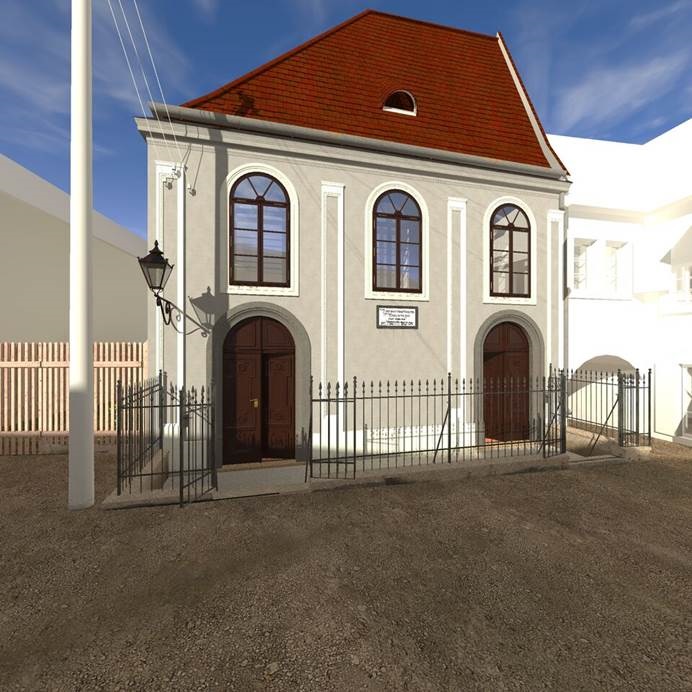
VS Reconstruction of Mattersburg Synagogue:
Left - Interior, facing East; Right - Main Entrance: left for men and right for ladies
There are many reconstructed synagogues at Beit Hatfutsot (The Museum of the Jewish
People) in Tel Aviv. Below is a reconstructed Austrian synagogue, the "Turnertemple" in
Vienna, from their collection:
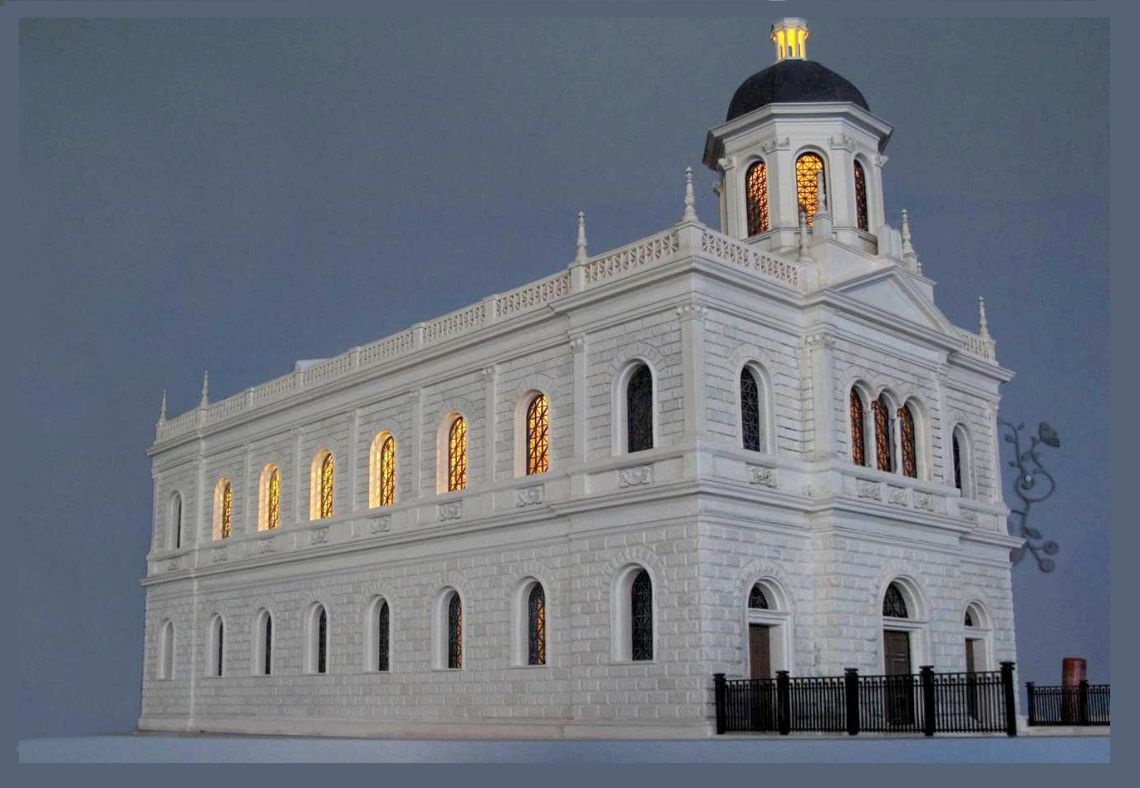
New Synagogue Model introduced to Beit Hatfutsot’s worldly collection
|
4) SERFDOM: RESTRICTIONS ON TRAVEL, ETC. (Part I)
John Rajkovacz writes: Hello Tom, a number of letters have discussed the movement of
different peoples from Bavaria, Styria, and Croatia etc. In brief discussions with my cousin who
lives in Eisenstadt and retired from govt. work, I know him to be a good source of information.
Even though, I have been there several times, there is so much to learn that many subjects are
not discussed. Recently, I asked whether family had been in Schachendorf and villages nearby as
far back as the 1700's, and he answered yes. There is the surname Ringlbauer mingled among other
surnames.
I was interested in one comment that he made that I feel has been incompletely discussed and
that is the restrictions that people had from physical movement to another area. He made
reference to the Freedom Act of about 1848 which allowed movement and ultimately led to
migrations. Can we have dialogue in this area?

I replied: Hi John, I haven’t been ignoring your question about Burgenländers having
restrictions on movement before 1848; instead, I have been researching the question, mostly
because I had never seen anything I trusted (like a cite to a law) that said movement was
actually restricted.
My recent research indicates that freedom of movement by peasants was revoked in response to the
1514 peasant uprising (the Dózsa rebellion) in Hungary, but it was restored to the peasants
between 1538 and 1547 and was never again restricted thereafter. Still, the Hungarian “April
Laws of 1848” included “emancipation” of peasants, so it is of interest to understand what
actually changed then... and perhaps to talk about the daily realities of the “peasant class”
between 1514 and 1848 that led to them being included in the ten “April Laws.” Thus, I will
construct an article on the topic, though it will not be in the next, end-of-August newsletter
nor the end-of-September edition, as I won’t be publishing one then (too much travel in
September!). Until then, yours...

Well, the "until then" has arrived and here is an article on the topic. I have
extracted material for this article from website
http://staff.lib.msu.edu/sowards/balkan/lecture4.html, from the book "Borderland," by
Andrew Burghardt, from various Wikipedia articles, and from a thesis submitted in 2009
for a PhD in History at the University College London, entitled "Land Reform and the
Hungarian Peasantry, c. 1700-1848," by Robert William Benjamin Gray, who is now Dr. Robert
Gray, a Professor and Lecturer in Environmental History, Humanities and Social Sciences at the
University of Winchester, in Winchester, UK. His thesis can be found here:
http://discovery.ucl.ac.uk/19321/1/19321.pdf.

The 1848 "April Laws"
I will start by listing the 1848 April Laws, which were the culmination of a popular
Hungarian-nationalist movement in the 1830s and 1840s that was strongly embraced by the ethnic
Hungarians (but ignored or offended the non-Magyar ethnic minorities). Next, I will describe the
immediate political situation that allowed these laws to be passed. Thereafter, I will turn the
calendar back to 1514 and work forward in time to give the background about serfdom that led to
its final abolition in Hungary.
Here are the 1848 April Laws:
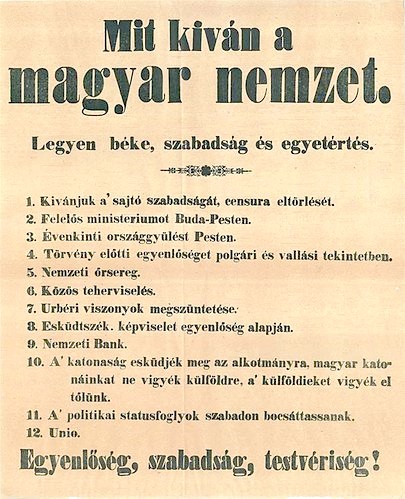 ■
First, all males aged at least 20 who met certain property requirements and spoke
Magyar would vote in elections to the lower chamber (this meant about 7 percent of the total
population: the upper house remained a hereditary house of lords). ■
First, all males aged at least 20 who met certain property requirements and spoke
Magyar would vote in elections to the lower chamber (this meant about 7 percent of the total
population: the upper house remained a hereditary house of lords).
■ Second, a similar electoral franchise law went into effect for the county and
municipal governments.
■ Third, toleration was extended to all Christian sects (but not Judaism): that is, all
such believers became eligible for all the rights of a citizen.
■ Fourth, peasant dues and servitude were abolished but the 635,000 peasant families
received no immediate title to the land they worked. Landlords would receive compensation,
details to be worked out later.
■ Fifth, taxation was extended to all, noble or not. The Catholic Church gave up its
state-collected tithe.
■ Sixth, patrimonial courts on estates were abolished. All citizens became subject to
the same system of courts, with a right to trial by jury.
■ Seventh, a national land bank for investment was set up.
■ Eighth, freedom of the press and of instruction in schools was established.
■ Ninth, a National Guard was created as an autonomous Hungarian armed force.
■ Tenth, administrative union with Transylvania was announced, pending confirmation by
the separate Transylvanian Diet (which consented unanimously in May).
As noted above, these laws were the end-result of the ongoing popular movement for Hungarian
nationalism and autonomy. Perhaps the best "gauge" of the degree of increasing ethnic
nationalism in Hungary leading up to these April Laws was the legislated extension of the
use of the Magyar language (generally supplanting Latin) in Hungarian-controlled territory:
-- in 1831, mastery of Hungarian (Magyar) became a requirement to pass the legal bar;
-- in 1838, it became the official language of laws passed in the Diet;
-- in 1839, it became the language of internal administrative memos, and was required of all
priests;
-- in 1843, it became the official language of administration, replacing Latin;
-- in 1844, it became the official language of secondary education;
-- in 1848 (as part of the April Laws), it became a test for voters.
These language laws clearly discriminated against German, Slovak, Romanian and South Slav
minorities in the western, northern, eastern and southern regions. While Magyars pursued
autonomy for themselves, they ignored the same desires among these groups. Further, Jews
remained second-class citizens, barred from holding any office.
 As
background, when the Hungarian Diet opened in March 1848, Lajos Kossuth, the
leader of the lower house in the Diet, demanded a new constitutional relationship between
the Austro-Hungarian crown and the Diet; it was easy to get the support of his lower
chamber. Then, when news arrived about the successful (though short-lived) revolution in Vienna,
the Palatine (the representative of the Habsburg monarch) joined the Hungarian national
cause and secured the consent of the upper house (the nobles) for a responsible, separate
Hungarian ministry. Fearing the revolution underway in Vienna, Emperor Ferdinand was too weak to
block the change. Thus having secured autonomous power, the Diet then passed the ten
sweeping April Laws. As
background, when the Hungarian Diet opened in March 1848, Lajos Kossuth, the
leader of the lower house in the Diet, demanded a new constitutional relationship between
the Austro-Hungarian crown and the Diet; it was easy to get the support of his lower
chamber. Then, when news arrived about the successful (though short-lived) revolution in Vienna,
the Palatine (the representative of the Habsburg monarch) joined the Hungarian national
cause and secured the consent of the upper house (the nobles) for a responsible, separate
Hungarian ministry. Fearing the revolution underway in Vienna, Emperor Ferdinand was too weak to
block the change. Thus having secured autonomous power, the Diet then passed the ten
sweeping April Laws.
I will note that the Diet voted later in April to depose the Habsburg dynasty, an act
which Emperor Ferdinand could not ignore. With the help of the Russians, the Magyars were
soundly defeated by the Hapsburgs in August 1849. One-hundred-fourteen captured officers were
shot or hanged, others sent to prison, and the Hungarian Revolution of 1848 was
officially defunct.
However, the revolution had had wide support by ethnic Hungarians, the county and state
legislature and executives, and the armed forces, so not every revolutionary measure could be
retracted. Thus the Habsburg regime supported some reforms. These were:
■ To curry favor with the peasantry in Austria, the Habsburgs had already ended the
remnants of serfdom through a March 1848 act of parliament. Like in Hungary, peasants received
title to some land, while landlords retained title to the remainder and received state-paid
compensation for lost dues. This was extended to Hungary.
■ Tariffs were abolished within the empire, thus creating a Customs Union, which ruined
a few industries but helped far more. Nobles benefited by investing the compensation received
for lands lost to emancipation, and many became rich through manufacturing.
■ The provincial Diets and separate regional bureaucracies were replaced by unified
national institutions to curb separatism: this step also reduced the power of the nobility.
The crown itself saw advantages in creating a single body that replaced the regional Diets
with their special privileges, in a revival of centralism.
■ In place of historic, medieval constitutional laws, the empire embraced modern ideas of
constitutional government, even if imposed from above.
After the defeat of 1849, Hungarian autonomy was abolished with the stroke of a pen. For
purposes of taxation, commerce and administration, Austria and Hungary became a single
centralized state. German replaced Latin and Hungarian as the language of official
business. The crown sought allies among groups without revolutionary associations. These
included the peasants, who emerged from 1848 grateful for their land; the "nouveau riche"
made up of beneficiaries of the tariff reform, both enterprising aristocrats and urban
capitalists; and harmless national minorities like the Polish nobility of Galicia, who preferred
Austrian rule to that of Russia.
Thus, that is where things stood after the creation, short life time, and quick dissolution of
the 1848 April Laws.
Now let us return back to 1514 to see when, why and what restrictions were applied to the rural
peasantry.

The Dózsa Rebellion
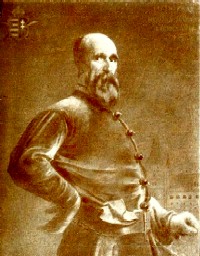 György
Dózsa (1470-1514) was a nobleman from Transylvania and a Székely man-at-arms during the
wars against the Ottoman Empire, where he won a reputation for valor. The peasant's rebellion,
which he led, occurred during the reign of King Vladislas II of Hungary (1490-1516), a time when
royal power declined in favor of the magnates, who used their power to curtail the peasants’
freedom. György
Dózsa (1470-1514) was a nobleman from Transylvania and a Székely man-at-arms during the
wars against the Ottoman Empire, where he won a reputation for valor. The peasant's rebellion,
which he led, occurred during the reign of King Vladislas II of Hungary (1490-1516), a time when
royal power declined in favor of the magnates, who used their power to curtail the peasants’
freedom.
The rebellion arose after Hungarian chancellor, Tamás Bakócz, returned from the Holy See in
early 1514 with a papal bull authorizing a crusade against the Ottomans. Dózsa was appointed to
organize and direct the crusade so he gathered an army of some 40,000 peasants, wandering
students, friars, and parish priests, all from the lowest-ranking groups of medieval society. By
the time he had provided them with some military training, they began to air the grievances of
their status, as no measures had been taken to supply them with food or clothing. As
harvest-time approached, the landlords commanded them to return to reap the fields, and, on
their refusing to do so, proceeded to maltreat their wives and families and set their armed
retainers upon the local peasantry.
The volunteers became increasingly angry at this and the failure of the nobility to provide
support and military leadership (the original and primary function of the nobility and the
justification for its higher status in the society). The rebellious, anti-landlord sentiment of
these "crusaders" became apparent during their march across the Great Hungarian Plain, so Bakócz
cancelled the campaign. The movement was thus diverted from its original object, and the
peasants and their leaders began a war of vengeance against the landlords. The rebellion spread
quickly, principally in the central or purely Magyar provinces, where hundreds of manor houses
and castles were burned and thousands of the gentry killed by impalement, crucifixion, and other
methods.
In reaction, the papal bull was revoked, and King Vladislas II issued a proclamation commanding
the peasantry to return to their homes under pain of death. By this time, the rising had
attained the dimensions of a full revolution. Vladislas called out all the vassals of the
kingdom and soldiers of fortune were hired to put down the revolt. Meanwhile, Dózsa had captured
the city and fortress of Csanád and signaled his victory by impaling the bishop and the
castellan. Subsequently, at Arad, the Lord Treasurer was seized and tortured to death. In
general, however, Dózsa only executed particularly vicious or greedy noblemen. However, he was
unable to consistently control his followers and many of them hunted down rivals.
During the course of the summer, Dózsa seized the fortresses of Arad, Lippa and Világos, thus
providing himself with cannons and trained gunners. One of his bands advanced to within 25
kilometers of the capital but his ill-armed ploughmen were outmatched by the heavy cavalry of
the nobles. Dózsa was finally routed by a large army at Temesvár and then captured. In
retribution, he was condemned to sit on a heated iron throne with a heated iron crown on his
head and a heated scepter in his hand (mocking at his ambition to be king). While he was
suffering in this way, a procession of fellow rebels, including his younger brother, were led to
his "throne" and required to eat his cooking flesh or be killed before him. Dózsa died on the
throne while the rebels who obeyed were let go without further harm.
The revolt was repressed but some 70,000 peasants were tortured. György's execution and the
brutal suppression of the peasants greatly aided the 1526 Ottoman invasion, as the Hungarians
were no longer a politically united people.
Another consequence was the creation of new laws through an effort in the Hungarian Diet
led by István Werboczy. The resulting Tripartitum elaborated the Doctrine of the Holy
Crown but also greatly enhanced the status of nobility, erecting an impassable barrier
between Hungarian nobility and peasantry until serfdom was fully abolished in 1848.

The Peasants, as Defined in Hungarian Law
Following the Dózsa rebellion of 1514, the peasantry were condemned to the status of 'perpetual
rusticity’ [rusticity is defined as "the state or quality of, relating to, or
living in the country, as distinguished from towns or cities; rural"]. By the laws of that
year, the peasants’ status as the "personally free but legally dependent tenants of their
lords" was confirmed. From then on, the peasants owed a set list of dues and services to a
lord (be this the crown, the church or a nobleman) in return for their right to farm the land.
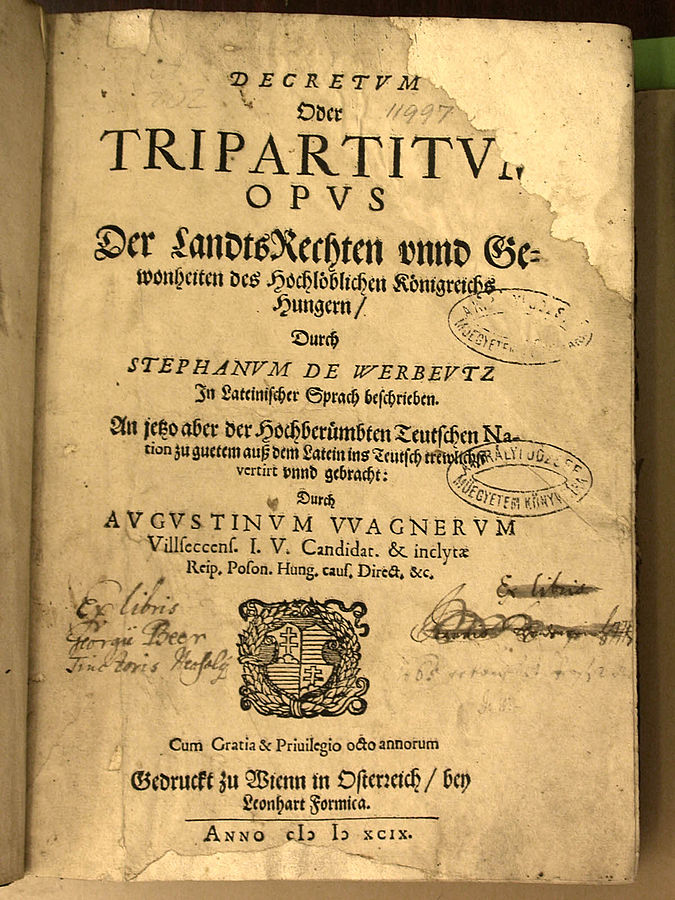 The
initial law formalizing the status of peasants was Stephen Werboczy’s Tripartitum,
a canon of Hungarian customary law produced in 1517. By being included in the Tripartitum,
the terms of the 1514 laws were cemented in what would become the principal text of Hungarian
law for almost three and a half centuries. However, by also expanding upon the rights associated
with ‘perpetual rusticity,’ the Tripartitum guaranteed to the peasantry the right of
hereditary tenure to the land. In other words, the peasants’ relationship both to their lords
and to the land they farmed was established in written law. Nevertheless, the terms of the
Tripartitum were vague and much remained customary and unwritten, the product of tacit
agreement and use. The
initial law formalizing the status of peasants was Stephen Werboczy’s Tripartitum,
a canon of Hungarian customary law produced in 1517. By being included in the Tripartitum,
the terms of the 1514 laws were cemented in what would become the principal text of Hungarian
law for almost three and a half centuries. However, by also expanding upon the rights associated
with ‘perpetual rusticity,’ the Tripartitum guaranteed to the peasantry the right of
hereditary tenure to the land. In other words, the peasants’ relationship both to their lords
and to the land they farmed was established in written law. Nevertheless, the terms of the
Tripartitum were vague and much remained customary and unwritten, the product of tacit
agreement and use.
The next legal document affecting the peasants status was the 1767 Urbarium issued
by the co-regents (from 1765 to 1780) of the Habsburg Monarchy, Holy Roman Emperor Joseph II and
his mother, Queen Maria Theresa. The Urbarium intended to supplant unwritten custom and
varied local use with a set of written and uniform standards. It aimed to record and regulate
the peasants’ holdings, and required registers to be kept to account for all peasant-farmed land
and the obligations that derived there from. As a consequence, the peasants’ urbarial
holdings—that land to which they possessed rights as they had been defined in the Tripartitum—became
permanently separated from their lords’ dominical land. At the same time, the peasants’
obligations became tied to the size of their holding in an attempt to ensure that the peasants
could subsist, pay taxes to the crown and meet their obligations to their lords.
By tasking county officials with overseeing the urbarial agreements and land registers, the
Urbarium brought written law more firmly into lord-peasant relations through the persons of
the county officials. Through these measures, the Urbarium was to supersede the
irregularity and lack of uniformity inherent in existing customary arrangements. But, as an
unintentional consequence, a third form of land emerged: the extra-urbarial land. The
peasants possessed only ill-defined customary rights to the extra-urbarial land,
established through local use and outside of those rights accounted for in written law. Thus,
the Tripartitum had defined the rights associated with ‘rusticity’ and the
Urbarium defined how far these rights extended onto the land. But the extent of rights to
the land was revealed more by what the Urbarium did not include than what it did. I will
return to this issue after discussing additional legal documents.
The July Decree of 1770 granted the peasants the right to justice through royal
officials rather than their lords' courts. The Patent of 1772 granted them the
right to appeal to the sovereign, and limited the robot (labor that lords could demand of
their serfs) to three days a week and twelve hours a day (note that this "limit" exceeded what
was considered customary in many locations, so caused difficulties for those peasants). The
October Decree of 1773 capped the price of letters of release, which serfs
could buy from their lords to gain their freedom.
Then, after his mother's death in 1780, Joseph II issued The Serfdom Patent
(Leibeigenschaft Patent) in 1781, aimed at abolishing aspects of the traditional
serfdom system of the Habsburg lands through the establishment of basic civil liberties for the
serfs. This was in contrast to his contemporaries, Catherine the Great of Russia and Frederick
the Great of Prussia, both of whom claimed to detest feudalism yet chose to appease their noble
classes by strengthening the serfdom system during their years in power.
The Emperor's primary objection to feudalism was economic, as much of the Habsburg 18th century
economy was based on agriculture. The nobles and clerics were traditionally exempt from taxes so
the burden fell mainly on the peasants. But, after paying dues to the landlord, the serfs were
unable to provide high tax revenues for Joseph's centralized state.
In theory, as noted above, the feudal system bound farmers to inherited pieces of land
and subjected them to the absolute control of their landlord. The landlord was obligated to
provide protection, in exchange for the serfs’ labor and goods. In practice, however, the degree
to which the system was applied varied widely between regions and even manors within regions.
The Serfdom Patent legally diminished the long-established mastery of the landlord
throughout the Empire and allowed the serfs to independently choose marriage partners, pursue
career choices, and move between estates.
Nonetheless, the Serfdom Patent was enforced inconsistently, if at all, among the various
Habsburg lands. The nobility in Bohemia refused to enact its provisions, while the Transylvanian
nobles simply chose not to notify the peasants in their region about this emancipation document.
The Hungarian estates claimed that their peasants were not serfs, but “tenants in fee simple,
who were fully informed as to their rights and duties by precise contracts” and continued to
restrict these “tenants.” In contrast, the peasants of the German-speaking provinces were
actually aided by the Patent. The 1781 Serfdom Patent allowed the serfs legal
rights throughout the Habsburg Monarchy, though the document did not affect the financial dues
and the physical corvée that the serfs legally owed to their landlords.
Joseph II continued to attempt to destroy the feudal system through laws such as his Tax
Decree of 1789. This law would have modernized Habsburg society, allowing for the end of
corvée and the beginnings of lower tax obligations. Although these latter reforms were
withdrawn upon his death in 1790, the personal freedom of serfs remained guaranteed through the
first half of the nineteenth century due to the consequences of the 1781 Serfdom Patent.

I now wish to return to the statement that "the extent of rights to the land
was revealed more by what the [1767] Urbarium did not include than what it did."
Before the 1767 Urbarium, rights to the land were held in numerous and varied ways
defined by local use and interpreted through customary arrangements. The
Urbarium reclassified the land in two ways, as either urbarial or dominical,
with a third, ‘extra-urbarial’ land, emerging by default, as these two classifications
did not reflect all existing forms of use.
As use of this ‘extra-urbarial’ land was not regulated by law, prior custom persevered
and played an important role in establishing the peasants’ rights and the terms of their
relations to their lords. The ubiquity of custom, in turn, ensured that negotiation between
lords and peasants to establish the peasants’ obligations and to define the peasants’ right to
the land, with occasional reference to the courts, formed a central part of normal lord-peasant
relations. In this way, lord-peasant relations and the peasants’ rights to the land found a way
to accommodate what the peasants’ perceived to be just, reasonable or, at the very least,
acceptable.
At this point, I'm going to share a long quote from Dr. Robert Gray's thesis, "Land
Reform and the Hungarian Peasantry, c. 1700-1848":
The Tripartitum and the Urbarium provided the main legal framework from which
the reformers of the 1830s and 1840s worked as they sought to reconstruct Hungarian rural
society. To achieve this end, the laws of the 1830s and the 1840s sought to make statute and
custom more aligned with rights accounted for and recorded in written law. Through the debates
at the diet, and the reforms that resulted from these debates, property rights and the
peasants’ legal status were reinterpreted in a way that enabled the emancipation in 1848. At
the ‘long diet’ of 1832/36, proposals were put forward for the voluntary redemption
[buying out] of the peasants’ urbarial obligations, as a consequence of which the
peasants’ urbarial holdings would become their permanent private property. Although
these proposals were rejected in 1836, only to become law in 1840 and 1844, in the lengthy
discussions the diet had asserted that the peasants’ rights to their urbarial
holdings amounted to full property rights. Furthermore, when addressing the allocation of
rights to the extra-urbarial lands, the diet established the principle that the
peasants’ customary use of these lands amounted to property rights that had to be acknowledged
in written law. Thus the diet provided means to convert customary use into statutory
rights, and for peasants and lords to resolve disputes over rights to the land where these
remained unclear. All that remained was to support the assertions made in 1836 with
appropriate legislation, which occurred with the laws passed in 1840, enabling redemption
agreements, and in 1844, granting full property rights to the peasantry.
This is apparent in the Urbarium, wherein distinctions were made between urbarial
and dominical land that had not existed before, and the regulation of the peasants’
obligations did not account for the various local and customary practices. The matter has been
further complicated as the terms of the Urbarium were subsequently adopted by
historians to define the legal position of the Hungarian peasantry, often without reference to
actual conditions. The failure of codification to adequately reflect customary practice and
local conditions left many aspects of property rights and lord peasant relations open to
doubt, and thus which could be exploited or played with by the peasantry or their lords
through negotiation with their each other and petition to the courts. Indeed, it was precisely
because the peasants’ rights remained rooted in customary practice not accounted for in
written law that negotiations were able to play such a large role in establishing the terms of
lord-peasant relations.
With few notable exceptions, historians have depicted the Hungarian peasantry in the era of ‘serfdom’
or ‘feudalism’, running from the Dózsa rebellion of 1514 to the emancipation
of 1848, as suffering from ever-increasing exploitation by their noble landlords. The
landlords, benefiting from political, economic, and social privileges, were able to squeeze
the peasantry for all it was worth. Landlords could claim almost limitless rents or other
services, relied on their serfs’ free "robot" labour to farm their estates,
appropriated the peasants’ land without reproach, and acted as judge and executioner through
the manorial and county courts. The peasant, having no legal existence and no established
rights, could hope to seek no redress against the unchecked power of his lord aside from the
occasional benevolent acts of the Crown. In light of this, the emancipation acts of 1848
become a moment of unrivalled historical importance, whereby nine million serfs (some eighty
percent of the population) were liberated from seigneurial dependence [dependence on a
feudal lord / the lord of a manor] and servile obligations, and were granted personal,
political and economic freedom for the first time.
Such a view has often relied upon on the letter of the law and the opinions of the many
critics of rural Hungarian society, without seeking to find how thoroughly the law was
applied, or questioning the agenda of the critics. A case in point is the frequent citing of
Gergely Berzeviczy, who produced one of the first "enlightened" attacks on Hungarian ‘feudalism’
in the late eighteenth century. Accepting without criticism the depiction of an oppressed and
overburdened peasantry provided by Berzeviczy, a man who never hid his reform agenda, is bound
to provide a coloured view of rural conditions. Equally, many attempts to analyse Hungarian
rural conditions have turned to what incomplete statistical evidence is available, taken from
urbarial agreements, censuses and land surveys. These accounts have emphasized the
growing numbers of landless peasants and the expansion of noble demesnes [lands
attached to a manor and retained for the owner’s own use], used to support the growing
impoverishment and oppression of the Hungarian peasant. Taken together, these accounts show a
peasantry that was largely powerless to react as ‘neo-serfdom’ became entrenched in
Hungary from the late eighteenth century onwards, and fits into the common view of the lands
east of the Elbe.
According to such accounts, Europe can be divided into East and West, along the line of the
Elbe.
West of the river, the peasantry, although still unfree, were not ‘serfs’, for they
owed dues and services in return for the land they farmed and not by virtue of being born
under the jurisdiction of a given estate: a system known by the German term Grundherrschaft.
It is often assumed that a peasant under Grundherrschaft owed dues in cash or kind but
not labour, offering a further distinction between the ‘seigneurialism’ of the West and
the ‘serfdom’ of the East.
To the east of the Elbe, peasants living under Gutsherrschaft owed dues and
particularly limitless obligatory labour (the robot) to their lords due to their legal
status, or by being born on a given estate. Thus, a peasant under Gutsherrschaft was,
to quote Tim Blanning, ‘to all intent and purpose a serf’; a view reinforced since the
peasant ‘could not leave, marry or choose his profession without the permission of his lord’.
But it is often too simple to label the peasants east of the Elbe as ‘serfs’ and, by
doing so, it becomes all too easy to ignore any rights they may have possessed or to allow the
peasants any independence of action.
On the other hand, the distinction between Grundherrschaft and Gutsherrschaft,
or ‘seigneurialism’ and ‘serfdom’, is of use when seeking to understand the
legal position of the peasantry. A peasant under ‘seigneurialism’ owed dues and
services to his lord in return for established rights, in particular the usufruct [the
right to enjoy the use and advantages of another’s property short of the destruction or waste
of its substance] of an area of land, recognized in customary or statute law: a peasant under
‘serfdom’, whilst capable of possessing such rights, owed dues and services merely by
virtue of his legal status. As we shall see, according to this distinction the peasants of
Hungary lived not under ‘serfdom’ but under ‘seigneurialism’. With this in mind,
it thus becomes easier to search for and identify the peasants’ rights, and any negative
preconceptions one associates with ‘serfdom’ can be left behind. A similar problem
presents itself when one tries to translate jobbágyság, the legal position of the
Hungarian peasantry prior to 1848, into English. More often than not, jobbágyság is
rendered as ‘serfdom’, and the jobbágy (an individual living under jobbágyság)
as a ‘serf’. But this does little to reveal the complex legal position of the Hungarian
peasant, and it fails to reflect the rights that derived from being a jobbágy. Worse
than this, by translating jobbágyság as serfdom the position of the Hungarian
peasantry inevitably becomes associated with the negative connotations the latter term carries
in English.
Dr. Gray's main argument in this quote is that to label the Hungarian peasant status as ‘serfdom’
misrepresents the reality of conditions, which were much closer to ‘seigneurialism’ than
has previously been assumed.

I'm going to suspend this article here, with the intent of resuming it in the next
newsletter. That follow-up article will consist almost solely of additional, selected quotes
from Dr. Gray's thesis, wherein he gives more details on the historical status of Hungarian
peasants over time, presents arguments based on Hungarian court cases that show the true
relationship between the peasantry and the noble lords, and gives specific examples of
peasant/lord relationships in Western Hungary. Until then...
|
5) HISTORICAL BB NEWSLETTER ARTICLES
Editor: This is part of our series designed to recycle interesting articles from the
BB Newsletters of 10 years ago. In the September 2006 edition, Gerry replied to a member
question but failed to provide a response that was up to his usual standards of accuracy and
precision. As such, I have chosen this forum to correct the errors and, hopefully, improve the
precision of the reply. The same corrective notes are being added to the archived newsletter.

THE BURGENLAND BUNCH NEWS No. 155
September 30, 2006
BURGENLAND COUNTIES (by Gerry Berghold)
Long-time member Firmus Opitz writes: Question: In some research I am doing
they ask for a county. I was under the assumption that, for example, the city of Tadten
(Mosontétény) and Apetlon (Mosonbánfalva), were the county names. Am I wrong?
Reply: You are wrong. What you mention are towns (Gemeinden) which
administer other villages. There are seven Burgenland (post-1921) counties or Bezirks.
From north to south they are Neusiedl am See, Eisenstadt, Mattersburg, Oberpullendorf, Oberwart,
Güssing and Jennersdorf. The counties in Hungary that border these Burgenland counties and which
were the Burgenland village counties pre-1921 are Vas, Sopron and Moson.
To find the county in which a village is located, see our Homepage, Albert's List
or click on the village names in the Village List. Tadten and Apetlon are in the
Bezirk of Neusiedl am See.
The Austrian governmental administration is similar to ours with Land (like Land
Salzburg) being equivalent to our State and Bezirk being equivalent to our
County, with the Bezirk cities mentioned being like our County Seat. There are
administrative differences of course. You will find more about governmental administration if
you search our newsletter archives.

Editorial notes, 2016:
1) It appears that Gerry may have misunderstood the (admittedly vague) question being posed when
he wrote his reply. The question actually appears to be whether the words in parentheses,
Mosontétény and Mosonbánfalva, were the county names. If so, the answer is still no,
but with some hedging: Mosontétény and Mosonbánfalva were the (full) pre-1921 Hungarian names
for the post-1921 German-named villages of Tadten and Apetlon (respectively). However, the "Moson"
part of the Hungarian name was, in fact, the pre-1921 Hungarian county name and
the remaining part was the actual Hungarian village name, with the "Moson"
part being added only to distinguish these villages from similarly-named villages in other
Hungarian counties.
2) Gerry also declared that "What you mention are towns (Gemeinden) which administer other
villages." This also is slightly wrong, as every village in district Neusiedl am See
is self-administered as its own Gemeinde (municipality) and none administer other
villages.
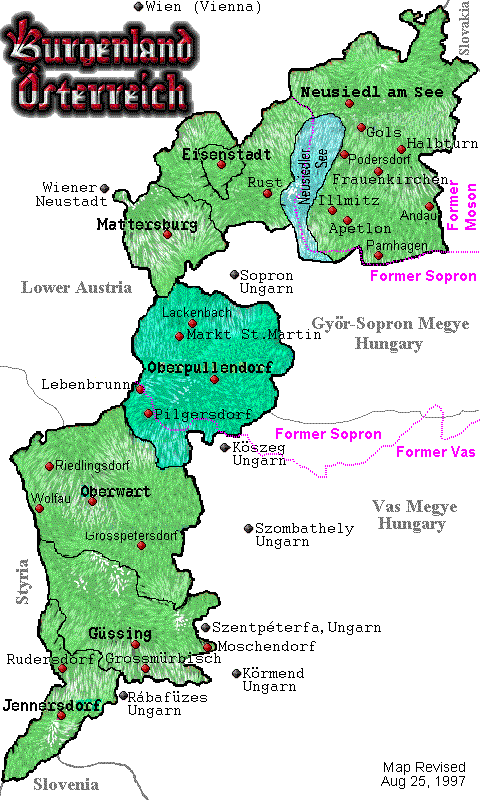 3)
Gerry also claimed that "The counties in Hungary that border these Burgenland counties and
which were the Burgenland village counties pre-1921 are Vas, Sopron and Moson." A
more-precise response would have been that Burgenland was created from parts of
the pre-1921 Hungarian counties of Vas, Sopron and Moson. However, after 1921, both "Moson" and
"Sopron" were discontinued as county names and "Györ-Sopron" became the new county name for most
of the land that remained in Hungary from those counties. I say only "most" because the border
between the old Sopron and Vas counties was redrawn, with some "Sopron" land being added to the
"new" Vas county and a smaller bit of "old" Vas land being added to the new Györ-Sopron county. 3)
Gerry also claimed that "The counties in Hungary that border these Burgenland counties and
which were the Burgenland village counties pre-1921 are Vas, Sopron and Moson." A
more-precise response would have been that Burgenland was created from parts of
the pre-1921 Hungarian counties of Vas, Sopron and Moson. However, after 1921, both "Moson" and
"Sopron" were discontinued as county names and "Györ-Sopron" became the new county name for most
of the land that remained in Hungary from those counties. I say only "most" because the border
between the old Sopron and Vas counties was redrawn, with some "Sopron" land being added to the
"new" Vas county and a smaller bit of "old" Vas land being added to the new Györ-Sopron county.
[In the map to the right, the pre-1921 county names and county lines are indicated in color
magenta. The post-1921 Hungarian county names and lines are
indicated in color silver gray.]
4) Gerry also made one more rather vague statement: "The Austrian governmental administration
is similar to ours with Land (like Land Salzburg) being equivalent to our State and Bezirk being
equivalent to our Counties, with the Bezirk cities mentioned being like our County Seat." It
is that last clause, "with the Bezirk cities mentioned being like our County Seat," that
I question, as neither Tadten nor Apetlon is a county seat. It may have been that Gerry was
referring to certain cities mentioned in the BB's Homepage, Albert's List or
Village List and not to the towns mentioned in the question asked. Regardless, Tadten and
Apetlon are only self-contained "Municipalities," not county seats.
|
6) ETHNIC EVENTS
LEHIGH VALLEY, PA
November 18 - December 18: Christkindlmarkt in Bethlehem. Info:
www.christmascity.org/christkindlmark/t.
November 18 - December 18: Weihnachtsmarkt in Bethlehem. Info:
www.getdowntownbethlehem.com/get-the-festivals/.
Tuesday, November 29: German-English Advent Singstunde in Bethlehem. Info:
www.moravianchurcharchives.org/events/german-english-advent-singstunde/.
NEW BRITAIN, CT
Friday, November 4, 7 pm: Heimat Abend. Austrian Donau Club, 545 Arch Street, $3.
Music by Joe Rogers and his band.
Friday, November 18, 7:30 pm: Heurigan Abend. Austrian Donau Club, 545 Arch
Street, $3. Music by Schachtelgebirger Musikanten.
ST. LOUIS, MO
Sunday, November 6, 2016, 2-5 pm: St Louis Gathering of Burgenländer and Descendants,
at the Community Center Cafeteria of the Holy Name of Jesus Catholic Church, 10235 Ashbrook Dr,
St. Louis. Contact Theresa McWilliams at
tmacwms@sbcglobal.net for more
information or to say you plan to attend.
UPPER MIDWEST
Sunday, November 6, 12-5 pm: Fall Meeting of the Upper Midwest Burgenland Bunch,
at the Ramsey County Library, 4570 Victoria Street North, Shoreview, MN (just off Highway 96
West). Bring a relative and some questions for the experts.
NEW HYDE PARK, NY
Sunday, November 13, 12:30 pm: Katharina Fest Dinner/Dance. New Hyde Park
Inn. Music by the Heimatklänge. Come meet other BB members. For info, call Frank
Paukowits (718-776-2716).
|
7) BURGENLAND EMIGRANT OBITUARIES
Stefan Feitl
 Stefan
Feitl, 84, of Brunswick, Ohio, passed away September 15, 2016. Stefan
Feitl, 84, of Brunswick, Ohio, passed away September 15, 2016.
He was the beloved husband of 60 years to Katherine (née Chesek).
Born July 24, 1932 in Alsószölnök (Unterzemming), Hungary, he was a son of the late Johann and
Anna (Kreitzer) Feitl.
Stefan was a U.S. Army Veteran and enjoyed family, woodworking and Florida.
He was the dear father of Elisabeth (James) Langan, Stefan (Jean), and Christine (Brian) Hurd;
dear Opa to Katherine (Michael) Edgar, Theresa (Nathaniel) Maier, Clarissa and Stephanie Feitl,
Julia, Nickolas and Adam Hurd; great-grandfather of Ella and Sylvia Edgar; loving brother of
Theresa Vass and the late Gustl, Janos, Julius, and Margaret Feitl, Maria Berces, Josephine
Buchesz.
Visitation Sunday 2-6 pm at Jardine Funeral Home, 15822 Pearl Rd. Strongsville. Mass of
Christian Burial Monday 9 am at St. Ambrose Church, Brunswick. Interment Holy Cross Cemetery.
Memorial contributions may be made to Hospice of the Western Reserve, 17865 St. Clair Ave.,
Cleveland, OH 44110. www.jardinefh.com.
Published in The Plain Dealer from Sept. 16 to Sept. 18, 2016

Charles Neubauer

Charles "Chuck" Neubauer, age 92, of Oshkosh, Wisconsin, passed away on Wednesday, September 28,
2016 at Evergreen/Sharehaven in Oshkosh.
Born October 2nd, 1923 in Neuberg, Austria, he was the son of the late Lukas and Louise
(Radostits) Neubauer.
He came to the United States at age three and was raised on the South Side of Chicago in the
Fuller Park neighborhood. He served in WWII as an Army medic, and was stationed in Europe, and
was present at the Battle of the Bulge.
In 1945 he met the love of his life, Louise Kalchbrenner, and they married in July of 1947. They
celebrated 66 years of marriage. She preceded him in death on July 22, 2013.
Chuck and Lou were blessed with two daughters, Karen (John) Fitzingo and Laura (David) Kevin.
Chuck and Lou were also like parents to their sons-in-law, John, Mike, and Barry. They were
further blessed with four grandchildren, Marilyn (Mike) Torbeck, Amanda (Darick) Durack, Brian
(Elsa) Kevin, and Erin (Joseph) Ludwig. They had two adorable great-grandsons, Otis and Charlie
Kevin.
Chuck was a storyteller extraordinaire, and loved to tell tales of his time on the road while
working as a machinist for Crompton-Knowles and the Redington Company. At home, he was a
creative and talented handyman and loved to work on projects. He delighted in making people
laugh, and had many good times with his sisters, Christine (Ed), and Pauline (Art), and his best
buddies, Otto (Carrie) and Rudy (Marie). He was loved and admired by his Kalchbrenner-in-laws
and nineteen nieces and nephews.
A celebration of Chuck's life will be held at 12:30 p.m. on Sunday, October 2, 2016, which was
also Chuck's birthday, at Konrad-Behlman Funeral Homes-Westside (100 Lake Pointe Dr.) with
Chaplain Chuck officiating. Visitation will be held at the funeral homes from 11:00 a.m. until
the time of the service. The family rejoices that he is once again with his "Honey Lou". The
family wishes to thank the wonderful staff at Evergreen/Sharehaven and Heartland Hospice who
cared for him with kindness and dignity.
Published in Oshkosh Northwestern on Sept. 30, 2016
|
END OF NEWSLETTER (Even good things must end!)
|
NOTICE (Terms and Conditions): The Burgenland Bunch (BB) was formed and exists to assist
Burgenland descendants in their research into their heritage and, toward that end, reserves the
right to use any communication you have with us (email, letter, phone conversation, data upload,
etc.) as part of our information exchange and educational research efforts.
• If you do not want your communication to be used for this purpose, indicate that it is
"confidential" and we will abide by that request.
• Correspondents who communicate with the BB without requesting confidentiality retain their
copyright but give a non-exclusive license to the BB allowing us to forward to BB members,
publish in our monthly newsletter or on our website, and/or subsequently and permanently archive
all or parts of such communications.
The Burgenland Bunch homepage (website) can be found at:
http://www.the-burgenland-bunch.org
Burgenland Bunch Newsletter, copyright © 2016 by The Burgenland Bunch
All rights reserved. Permission to copy excerpts granted if credit is provided. |
 After
the bits and pieces here in my "Corner," we continue with Article 2—one
of my favorite types of articles—being a story about personal
discovery by a BB member. Patricia Rosa hadn't known Her Name Was Emilie!
Read the article to find out who Emilie was and how her name was discovered; it
will be worth your time!
After
the bits and pieces here in my "Corner," we continue with Article 2—one
of my favorite types of articles—being a story about personal
discovery by a BB member. Patricia Rosa hadn't known Her Name Was Emilie!
Read the article to find out who Emilie was and how her name was discovered; it
will be worth your time! Trans-Atlantic
Germanic Genealogy Conference: John Leier wrote to me to ask that I provide early
notice about a new genealogical conference to be held next summer, July 28-30, at the
Minneapolis Marriott Northwest Hotel in Brooklyn Park, MN. The conference overview can be found
here and the website for the host organization is
http://www.ggsmn.org.
Trans-Atlantic
Germanic Genealogy Conference: John Leier wrote to me to ask that I provide early
notice about a new genealogical conference to be held next summer, July 28-30, at the
Minneapolis Marriott Northwest Hotel in Brooklyn Park, MN. The conference overview can be found
here and the website for the host organization is
http://www.ggsmn.org. Burgenland/July
2016: Heimatabend in Stegersbach:
Burgenland/July
2016: Heimatabend in Stegersbach:  Roswitha
Marton wrote to Members Editor Johnny Santana:
Roswitha
Marton wrote to Members Editor Johnny Santana: Holling
destroyed its church records in 1946, taking my family history and leaving more questions than
answers. I knew my great-grandparents' names, but not their birth or death dates. My mother
always spoke about her step-grandmother and how much she loved her, and vice-versa,
but I didn’t know even her name.
Holling
destroyed its church records in 1946, taking my family history and leaving more questions than
answers. I knew my great-grandparents' names, but not their birth or death dates. My mother
always spoke about her step-grandmother and how much she loved her, and vice-versa,
but I didn’t know even her name. I
searched online unsuccessfully for Holling, Hungary. My next step was to scour the boxes
that my brother Larry stored for me—all the things I wanted to keep
from my parents’ home but didn’t have space for myself. One after another, we looked through a
box and then replaced it and started another.
I
searched online unsuccessfully for Holling, Hungary. My next step was to scour the boxes
that my brother Larry stored for me—all the things I wanted to keep
from my parents’ home but didn’t have space for myself. One after another, we looked through a
box and then replaced it and started another. Expulsion?
Wait, what? I Googled expulsion and read everything I could. I cried for the 13-year-old
girl, forced to leave everything behind. My siblings and I didn’t know half of the story, not
even close. I was confused, and I didn’t understand why I didn’t learn this from my mother? Why
weren’t they bitter? I don’t understand.
Expulsion?
Wait, what? I Googled expulsion and read everything I could. I cried for the 13-year-old
girl, forced to leave everything behind. My siblings and I didn’t know half of the story, not
even close. I was confused, and I didn’t understand why I didn’t learn this from my mother? Why
weren’t they bitter? I don’t understand. I
located a picture of my mother standing in front of the Holling/Fertöboz sign on
her first return trip to Holling in 46 years. Now it made sense, and I began searching
Fertöboz... our village came to life for me! Fertöboz was mentioned in a
Burgenland Bunch newsletter, so I became a member. Through this group, I connected with my
distant cousin in Germany! Her grandfather and my grandfather were cousins. I remembered meeting
her grandfather several times when I was with my Opa. We exchanged emails and pictures.
She shared with me some family history out of a book about Holling. I now have so much more
information, dates, and the names of my great-great-grandparents. One name that still eluded me
was the name of my step-great-grandmother. I returned to my document—and
there it was! Emilie, her name was Emilie.
I
located a picture of my mother standing in front of the Holling/Fertöboz sign on
her first return trip to Holling in 46 years. Now it made sense, and I began searching
Fertöboz... our village came to life for me! Fertöboz was mentioned in a
Burgenland Bunch newsletter, so I became a member. Through this group, I connected with my
distant cousin in Germany! Her grandfather and my grandfather were cousins. I remembered meeting
her grandfather several times when I was with my Opa. We exchanged emails and pictures.
She shared with me some family history out of a book about Holling. I now have so much more
information, dates, and the names of my great-great-grandparents. One name that still eluded me
was the name of my step-great-grandmother. I returned to my document—and
there it was! Emilie, her name was Emilie. Ed.
Note: The Holling/Fertöboz deportation-related document has been added to the BB's
Emigration & Deportation
page. Readers are invited to share any lists of deportations or emigrations they have for
inclusion in this page. My thanks to Patricia for sharing hers (and her story).
Ed.
Note: The Holling/Fertöboz deportation-related document has been added to the BB's
Emigration & Deportation
page. Readers are invited to share any lists of deportations or emigrations they have for
inclusion in this page. My thanks to Patricia for sharing hers (and her story).
 3)
Gerry also claimed that "The counties in Hungary that border these Burgenland counties and
which were the Burgenland village counties pre-1921 are Vas, Sopron and Moson." A
more-precise response would have been that Burgenland was created from parts of
the pre-1921 Hungarian counties of Vas, Sopron and Moson. However, after 1921, both "Moson" and
"Sopron" were discontinued as county names and "Györ-Sopron" became the new county name for most
of the land that remained in Hungary from those counties. I say only "most" because the border
between the old Sopron and Vas counties was redrawn, with some "Sopron" land being added to the
"new" Vas county and a smaller bit of "old" Vas land being added to the new Györ-Sopron county.
3)
Gerry also claimed that "The counties in Hungary that border these Burgenland counties and
which were the Burgenland village counties pre-1921 are Vas, Sopron and Moson." A
more-precise response would have been that Burgenland was created from parts of
the pre-1921 Hungarian counties of Vas, Sopron and Moson. However, after 1921, both "Moson" and
"Sopron" were discontinued as county names and "Györ-Sopron" became the new county name for most
of the land that remained in Hungary from those counties. I say only "most" because the border
between the old Sopron and Vas counties was redrawn, with some "Sopron" land being added to the
"new" Vas county and a smaller bit of "old" Vas land being added to the new Györ-Sopron county.
 Stefan
Feitl, 84, of Brunswick, Ohio, passed away September 15, 2016.
Stefan
Feitl, 84, of Brunswick, Ohio, passed away September 15, 2016.
 News
News Burgenland-Related
Research Survey: Although I sent a separate note concerning this, I wish to remind you
about the Online Research Survey being undertaken as part of his Master’s thesis by Martin
Schmall, a graduate student in Agriculture and Food Industry at the University of Natural
Resources and Life Sciences in Vienna, Austria. As I said in that note:
Burgenland-Related
Research Survey: Although I sent a separate note concerning this, I wish to remind you
about the Online Research Survey being undertaken as part of his Master’s thesis by Martin
Schmall, a graduate student in Agriculture and Food Industry at the University of Natural
Resources and Life Sciences in Vienna, Austria. As I said in that note: St.
Louis Online Genealogical Resources: Margaret Kaiser passed along information about
genealogical resources (newspaper databases) relating to the St. Louis area:
St.
Louis Online Genealogical Resources: Margaret Kaiser passed along information about
genealogical resources (newspaper databases) relating to the St. Louis area:
 Brothers
Grimm Fairy Tales in the Hianzisch Dialect: Karin Ritter, of the Burgenländisches
Volksliedwerk (Burgenland Folk Song), asked that I publish information about a new double-CD
set containing 13 Brothers Grim fairy tales presented in the Hianzisch dialect. The double-CD
was produced in cooperation with the Burgenländisch Hianzischen Gesellschaft in
Oberschützen and is based on text from their 2015 book, "Dou woar amul...", which
contains 27 of the best-known Brothers Grimm fairy tales, also presented in the Hianzisch
dialect. The double-CD was motivated because many readers of the book reported that they had
great problems reading the dialect, as Hianzisch is mostly a spoken, not written, dialect.
Brothers
Grimm Fairy Tales in the Hianzisch Dialect: Karin Ritter, of the Burgenländisches
Volksliedwerk (Burgenland Folk Song), asked that I publish information about a new double-CD
set containing 13 Brothers Grim fairy tales presented in the Hianzisch dialect. The double-CD
was produced in cooperation with the Burgenländisch Hianzischen Gesellschaft in
Oberschützen and is based on text from their 2015 book, "Dou woar amul...", which
contains 27 of the best-known Brothers Grimm fairy tales, also presented in the Hianzisch
dialect. The double-CD was motivated because many readers of the book reported that they had
great problems reading the dialect, as Hianzisch is mostly a spoken, not written, dialect. The
first site helps find the gravesites of fallen WW-II German and Austrian soldiers:
The
first site helps find the gravesites of fallen WW-II German and Austrian soldiers:
 On
March 12, 1938, Nazi Germany brought Austria home into the Reich (realm) by annexing the
country. With it began a terrible history of suffering for the victims of the Nazis: Jewish
people, free masons, Sinti and Roma, priests and believers of diverse Christian
denominations, representatives and exponents of the labor movement. They were disenfranchised,
humiliated, persecuted, arrested, robbed, expelled, and assassinated. Favored objects of the new
masters’ desires were the properties and cultural commodities of any kind: paintings,
sculptures, images, manuscripts, writings, archival materials, art wares, tools and instruments,
stocks, motor vehicles, furniture and usable items of any kind. One does not go wrong in the
assumption that there had to have been about 600,000 art works and millions of publications
confiscated from all over Europe.
On
March 12, 1938, Nazi Germany brought Austria home into the Reich (realm) by annexing the
country. With it began a terrible history of suffering for the victims of the Nazis: Jewish
people, free masons, Sinti and Roma, priests and believers of diverse Christian
denominations, representatives and exponents of the labor movement. They were disenfranchised,
humiliated, persecuted, arrested, robbed, expelled, and assassinated. Favored objects of the new
masters’ desires were the properties and cultural commodities of any kind: paintings,
sculptures, images, manuscripts, writings, archival materials, art wares, tools and instruments,
stocks, motor vehicles, furniture and usable items of any kind. One does not go wrong in the
assumption that there had to have been about 600,000 art works and millions of publications
confiscated from all over Europe. Update
for book "The Burgenländer Emigration to America": Here is this month's update on
purchases of the English issue of the 3rd edition of Dr. Walter Dujmovits' book "Die
Amerika-Wanderung Der Burgenländer."
Update
for book "The Burgenländer Emigration to America": Here is this month's update on
purchases of the English issue of the 3rd edition of Dr. Walter Dujmovits' book "Die
Amerika-Wanderung Der Burgenländer." Burgenland
Recipes: Eszter Tóth, of Vác, Hungary (who shared a Burgenland trip report
with us in Newsletter #268), tells me that her grandfather wrote up the old recipes of his wife
(her grandmother) in about 1917. Eszter shares one for "Dara Puding," saying "It
was family legend that this recipe was coming with my great-grandmother, so maybe has Burgenland
roots. Anyway I love it."
Burgenland
Recipes: Eszter Tóth, of Vác, Hungary (who shared a Burgenland trip report
with us in Newsletter #268), tells me that her grandfather wrote up the old recipes of his wife
(her grandmother) in about 1917. Eszter shares one for "Dara Puding," saying "It
was family legend that this recipe was coming with my great-grandmother, so maybe has Burgenland
roots. Anyway I love it."





 Reminder:
As mentioned a few newsletters ago, I no longer have a "regular" source for Burgenland recipes.
As above, a few readers have shared favorite family recipes so I'm good for a few months, but
then I'll be begging again! So, please consider sharing your favorite Burgenland recipes
or recipe books with me so I can share them with the readership... and so our ethnic dishes do
not get washed away by the ever flowing river of time and become lost to our future generations.
Thanks!
Reminder:
As mentioned a few newsletters ago, I no longer have a "regular" source for Burgenland recipes.
As above, a few readers have shared favorite family recipes so I'm good for a few months, but
then I'll be begging again! So, please consider sharing your favorite Burgenland recipes
or recipe books with me so I can share them with the readership... and so our ethnic dishes do
not get washed away by the ever flowing river of time and become lost to our future generations.
Thanks!








 ■
First, all males aged at least 20 who met certain property requirements and spoke
Magyar would vote in elections to the lower chamber (this meant about 7 percent of the total
population: the upper house remained a hereditary house of lords).
■
First, all males aged at least 20 who met certain property requirements and spoke
Magyar would vote in elections to the lower chamber (this meant about 7 percent of the total
population: the upper house remained a hereditary house of lords). As
background, when the Hungarian Diet opened in March 1848, Lajos Kossuth, the
leader of the lower house in the Diet, demanded a new constitutional relationship between
the Austro-Hungarian crown and the Diet; it was easy to get the support of his lower
chamber. Then, when news arrived about the successful (though short-lived) revolution in Vienna,
the Palatine (the representative of the Habsburg monarch) joined the Hungarian national
cause and secured the consent of the upper house (the nobles) for a responsible, separate
Hungarian ministry. Fearing the revolution underway in Vienna, Emperor Ferdinand was too weak to
block the change. Thus having secured autonomous power, the Diet then passed the ten
sweeping April Laws.
As
background, when the Hungarian Diet opened in March 1848, Lajos Kossuth, the
leader of the lower house in the Diet, demanded a new constitutional relationship between
the Austro-Hungarian crown and the Diet; it was easy to get the support of his lower
chamber. Then, when news arrived about the successful (though short-lived) revolution in Vienna,
the Palatine (the representative of the Habsburg monarch) joined the Hungarian national
cause and secured the consent of the upper house (the nobles) for a responsible, separate
Hungarian ministry. Fearing the revolution underway in Vienna, Emperor Ferdinand was too weak to
block the change. Thus having secured autonomous power, the Diet then passed the ten
sweeping April Laws. György
Dózsa (1470-1514) was a nobleman from Transylvania and a Székely man-at-arms during the
wars against the Ottoman Empire, where he won a reputation for valor. The peasant's rebellion,
which he led, occurred during the reign of King Vladislas II of Hungary (1490-1516), a time when
royal power declined in favor of the magnates, who used their power to curtail the peasants’
freedom.
György
Dózsa (1470-1514) was a nobleman from Transylvania and a Székely man-at-arms during the
wars against the Ottoman Empire, where he won a reputation for valor. The peasant's rebellion,
which he led, occurred during the reign of King Vladislas II of Hungary (1490-1516), a time when
royal power declined in favor of the magnates, who used their power to curtail the peasants’
freedom. The
initial law formalizing the status of peasants was Stephen Werboczy’s Tripartitum,
a canon of Hungarian customary law produced in 1517. By being included in the Tripartitum,
the terms of the 1514 laws were cemented in what would become the principal text of Hungarian
law for almost three and a half centuries. However, by also expanding upon the rights associated
with ‘perpetual rusticity,’ the Tripartitum guaranteed to the peasantry the right of
hereditary tenure to the land. In other words, the peasants’ relationship both to their lords
and to the land they farmed was established in written law. Nevertheless, the terms of the
Tripartitum were vague and much remained customary and unwritten, the product of tacit
agreement and use.
The
initial law formalizing the status of peasants was Stephen Werboczy’s Tripartitum,
a canon of Hungarian customary law produced in 1517. By being included in the Tripartitum,
the terms of the 1514 laws were cemented in what would become the principal text of Hungarian
law for almost three and a half centuries. However, by also expanding upon the rights associated
with ‘perpetual rusticity,’ the Tripartitum guaranteed to the peasantry the right of
hereditary tenure to the land. In other words, the peasants’ relationship both to their lords
and to the land they farmed was established in written law. Nevertheless, the terms of the
Tripartitum were vague and much remained customary and unwritten, the product of tacit
agreement and use.